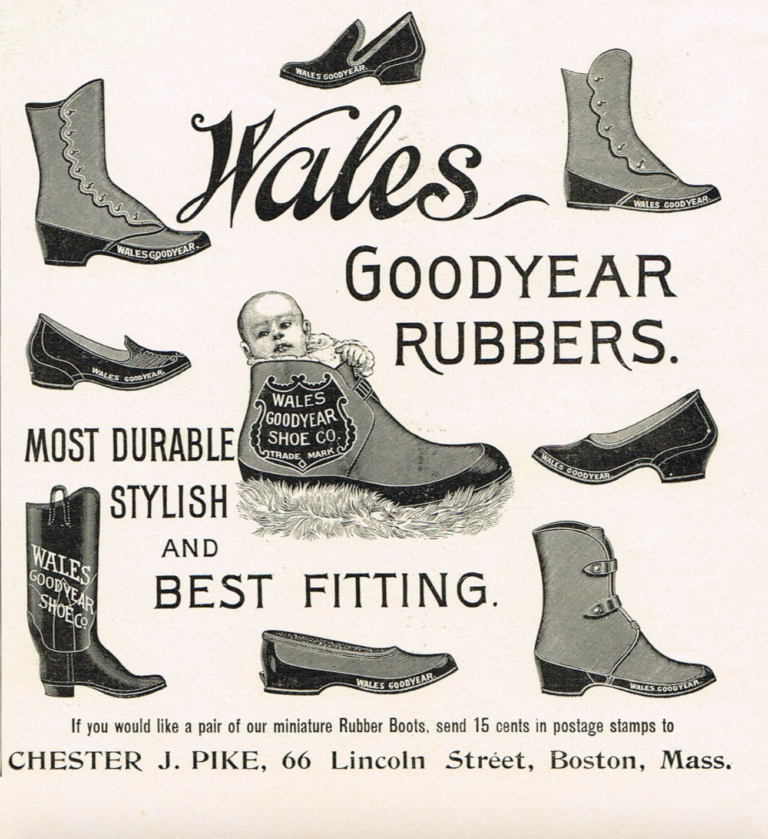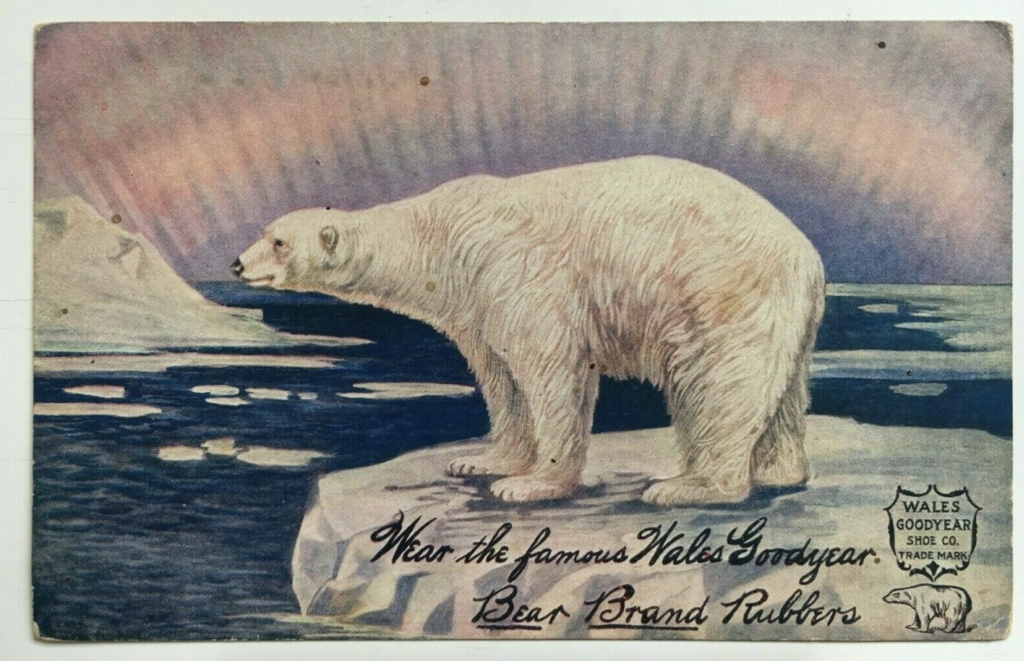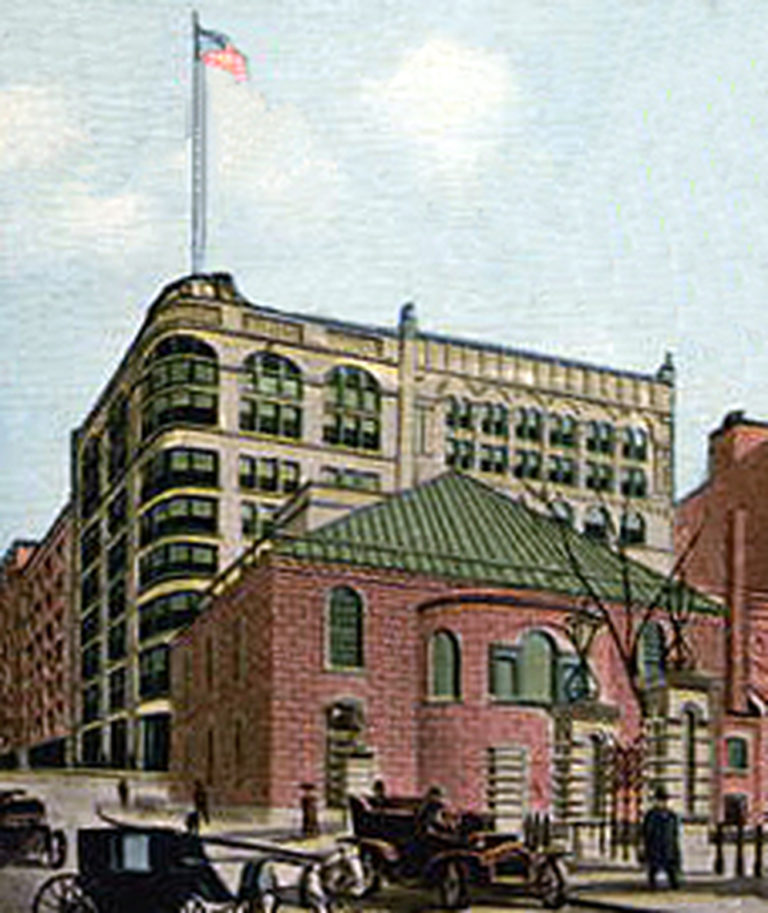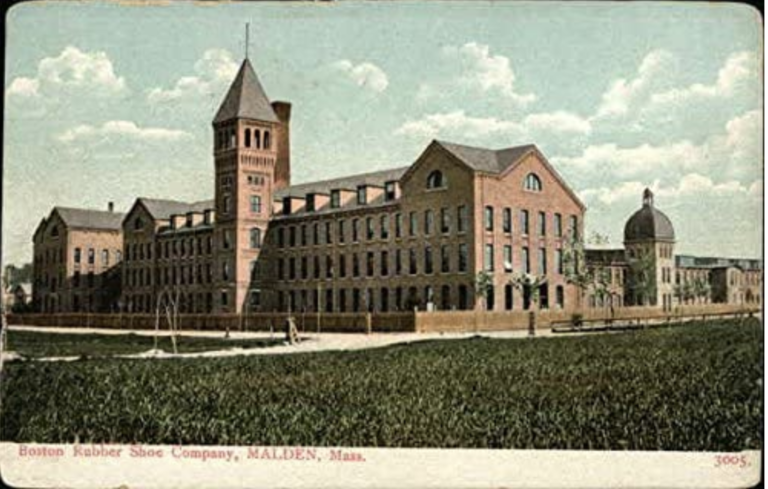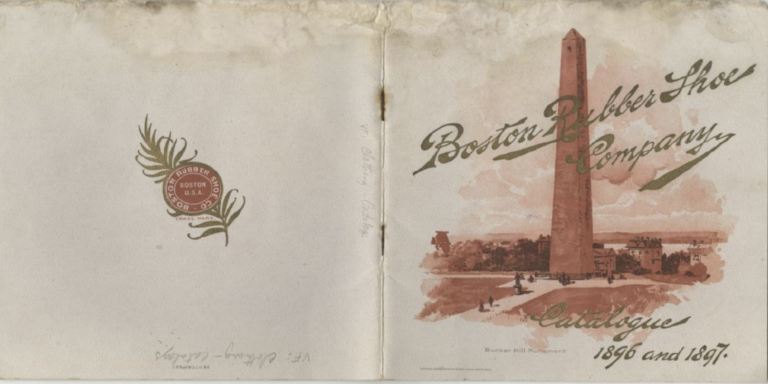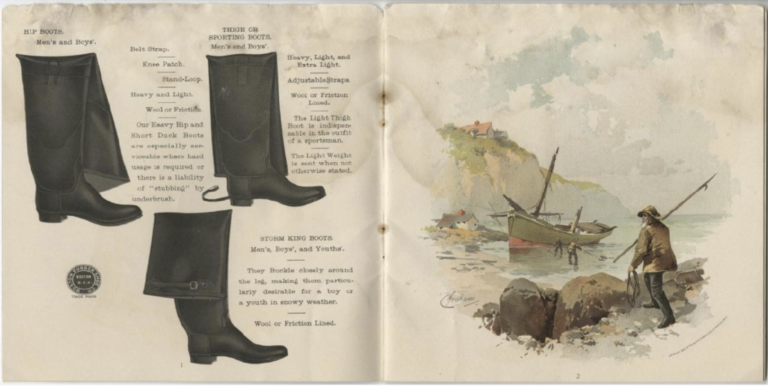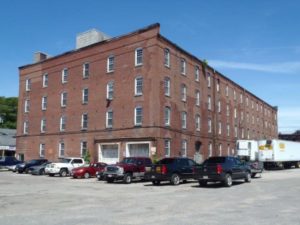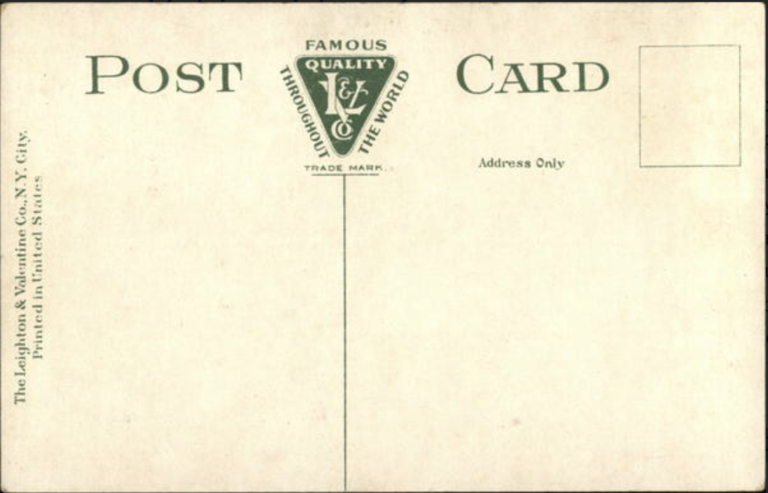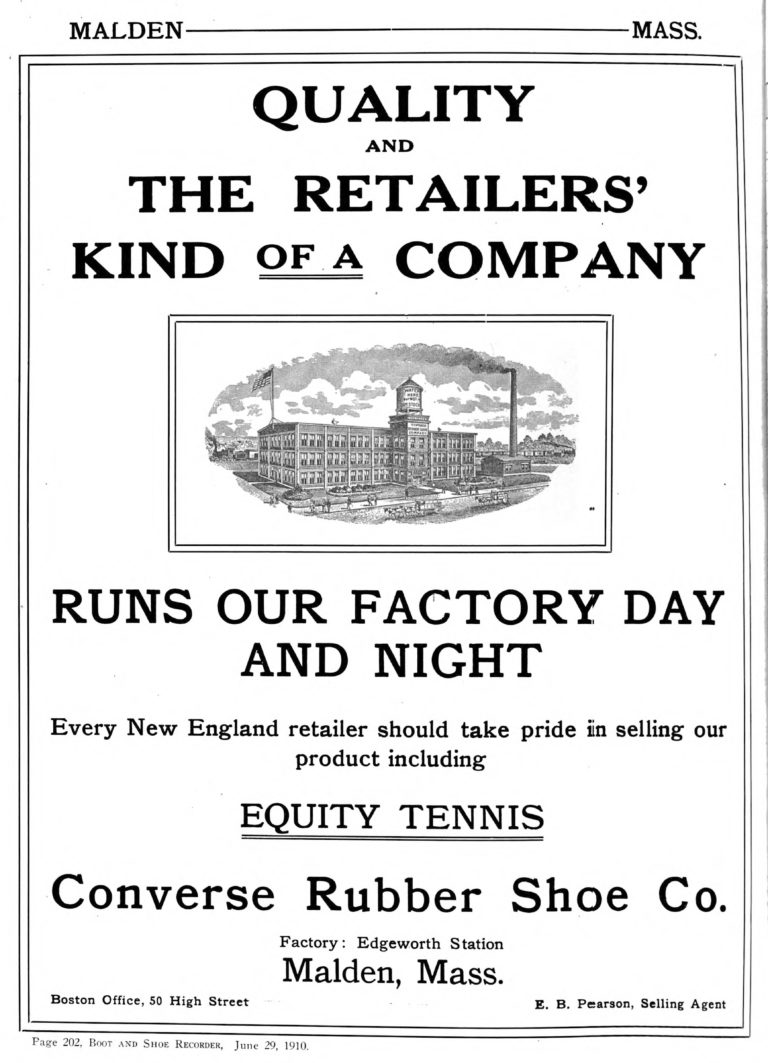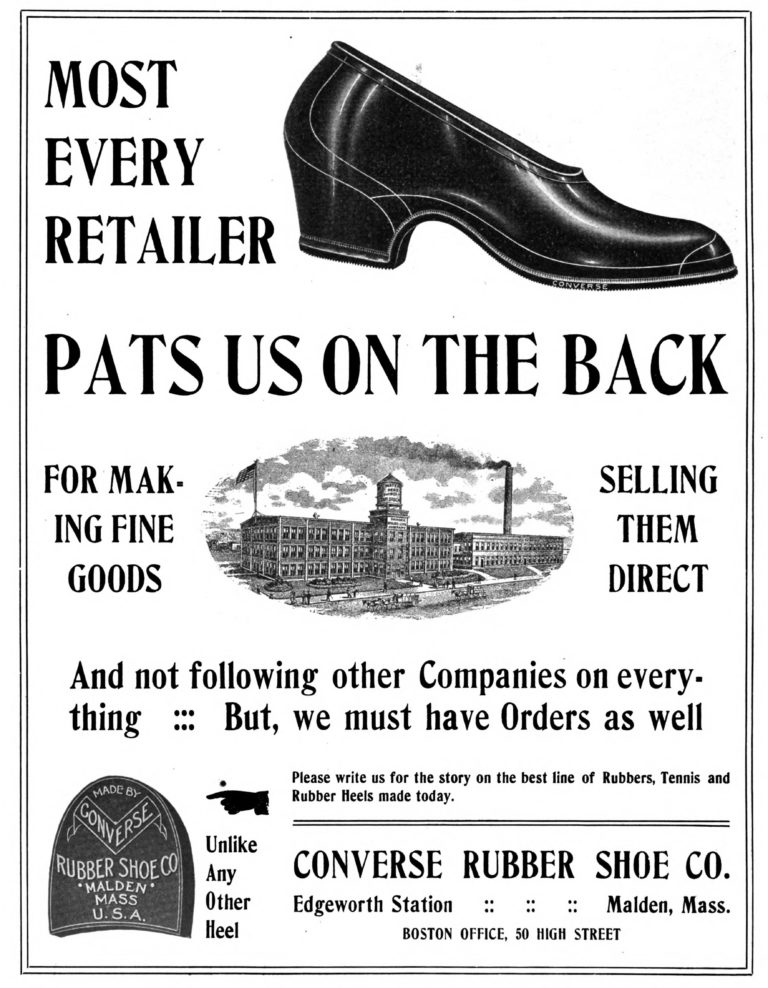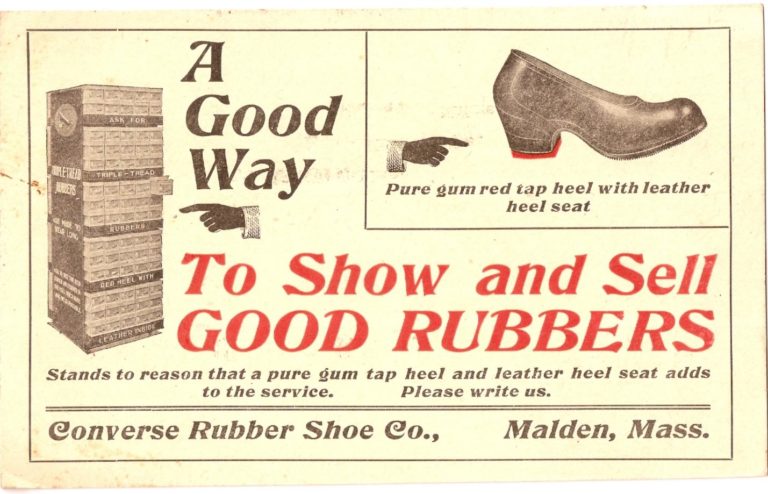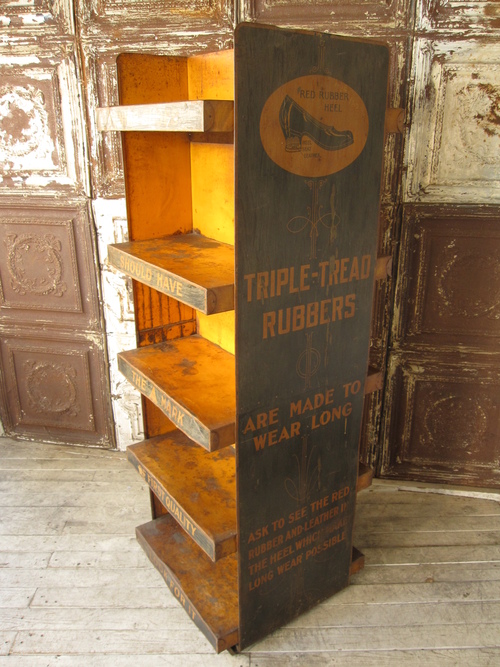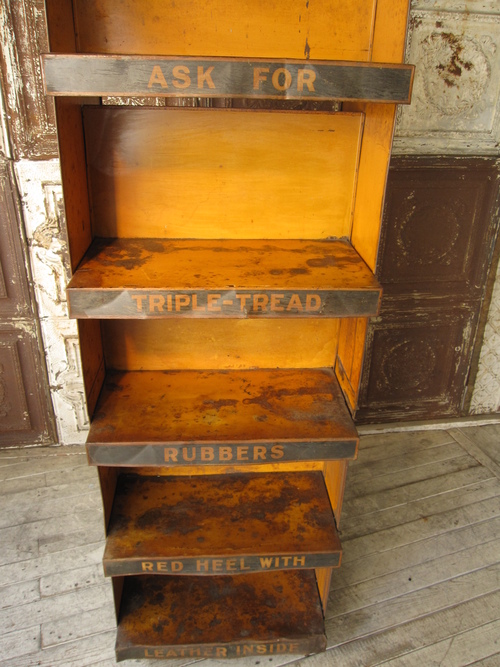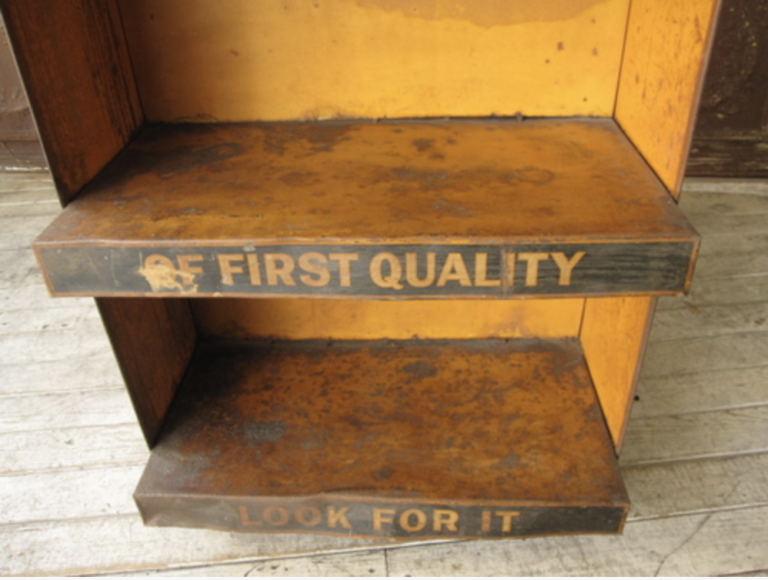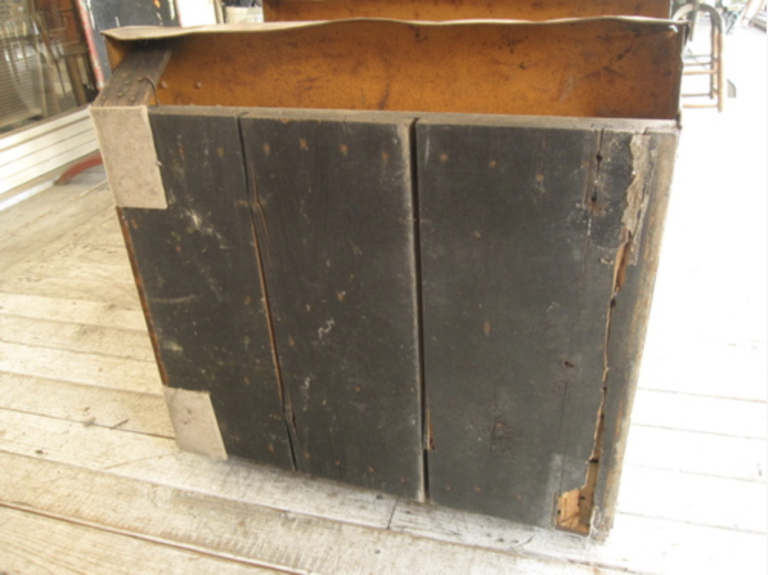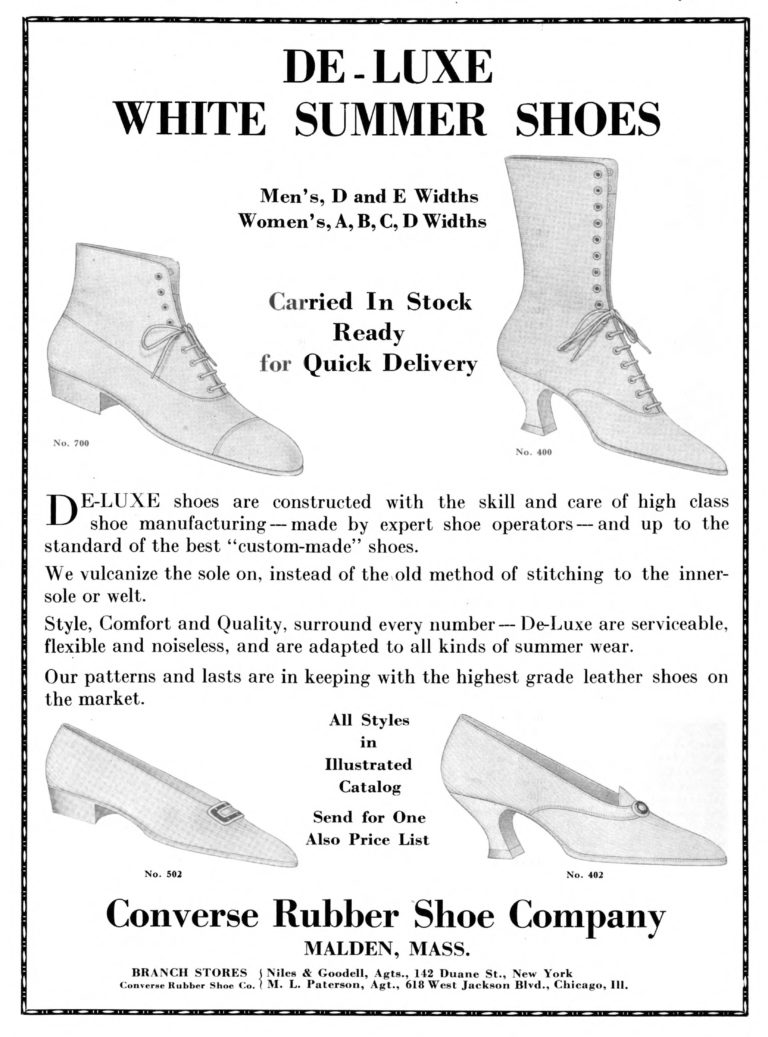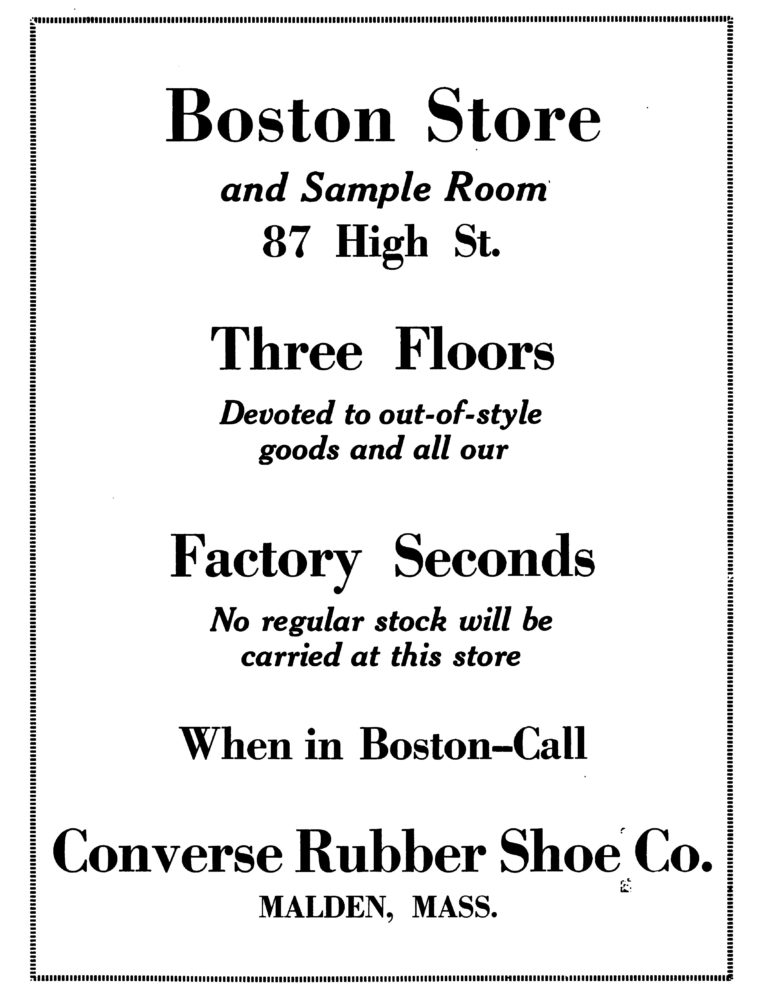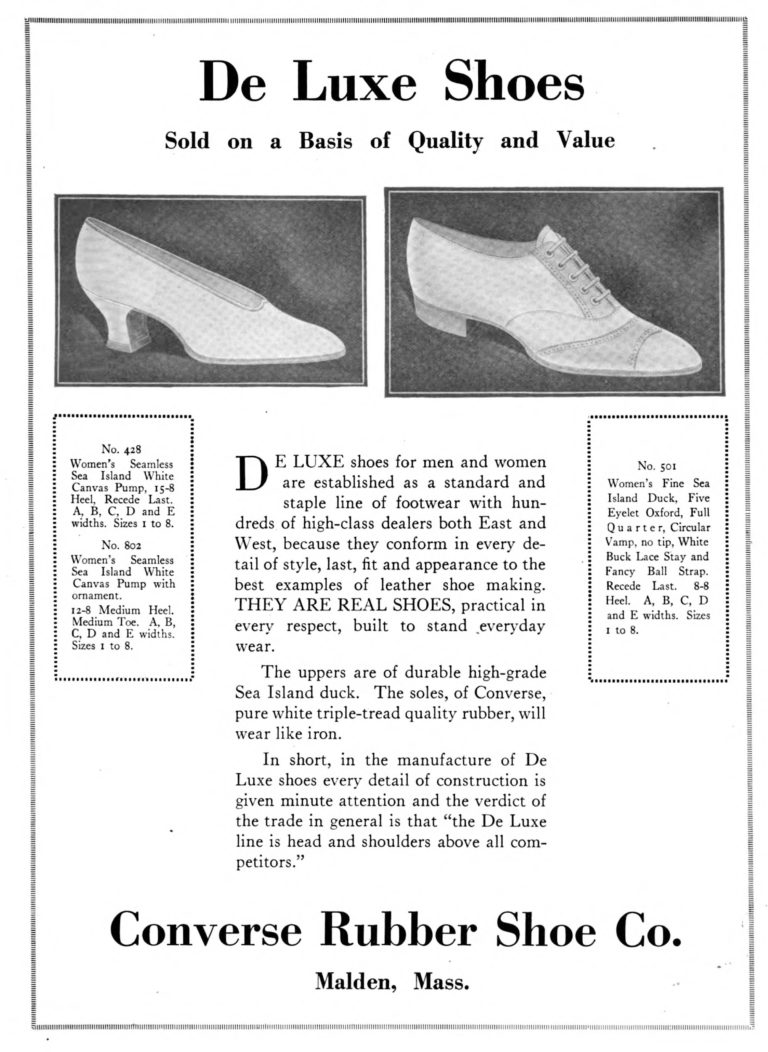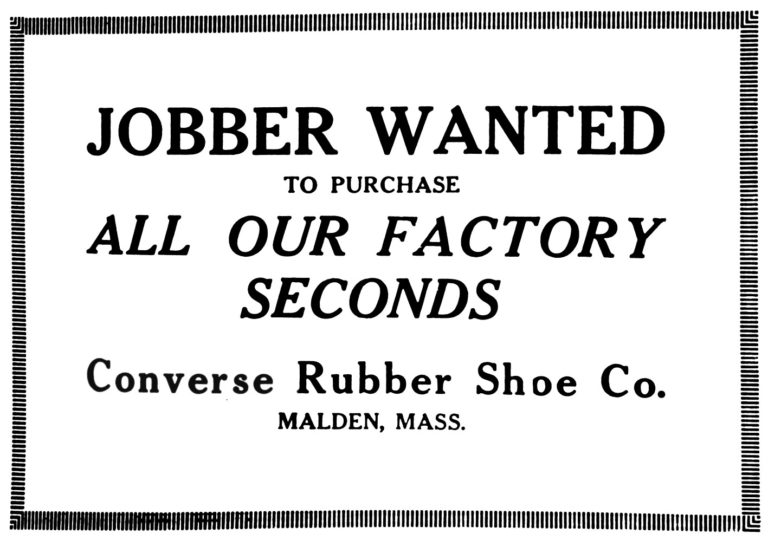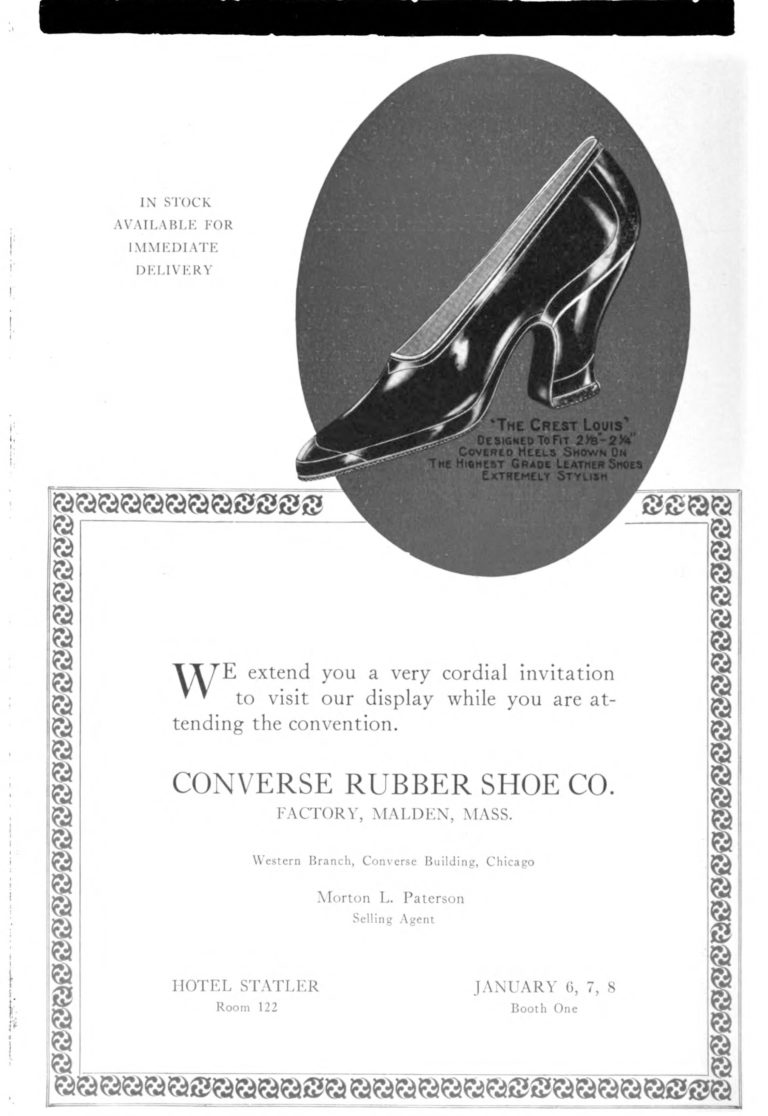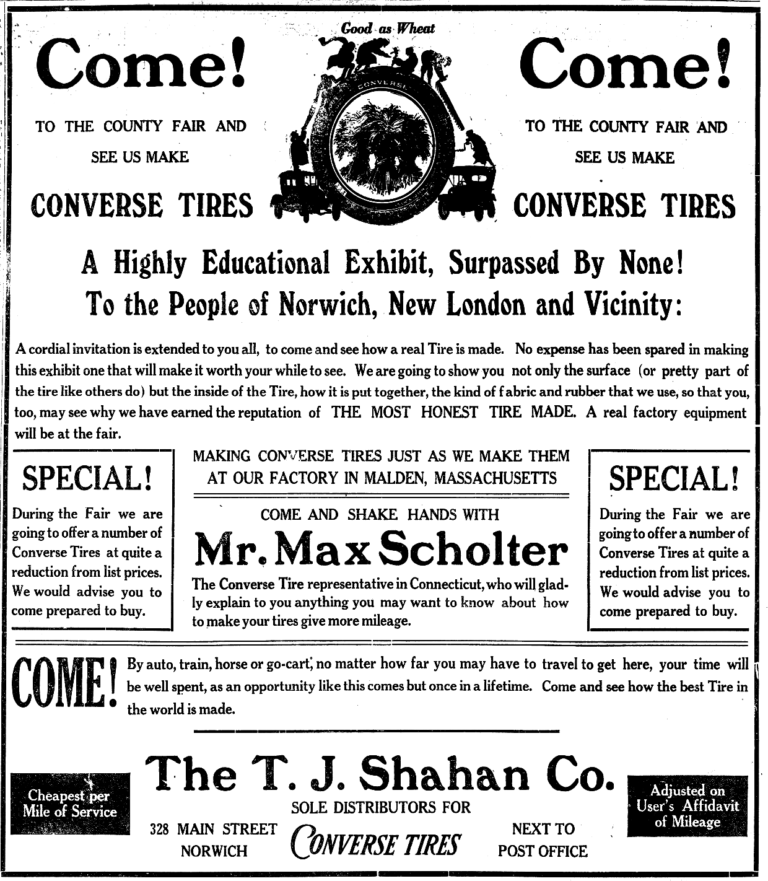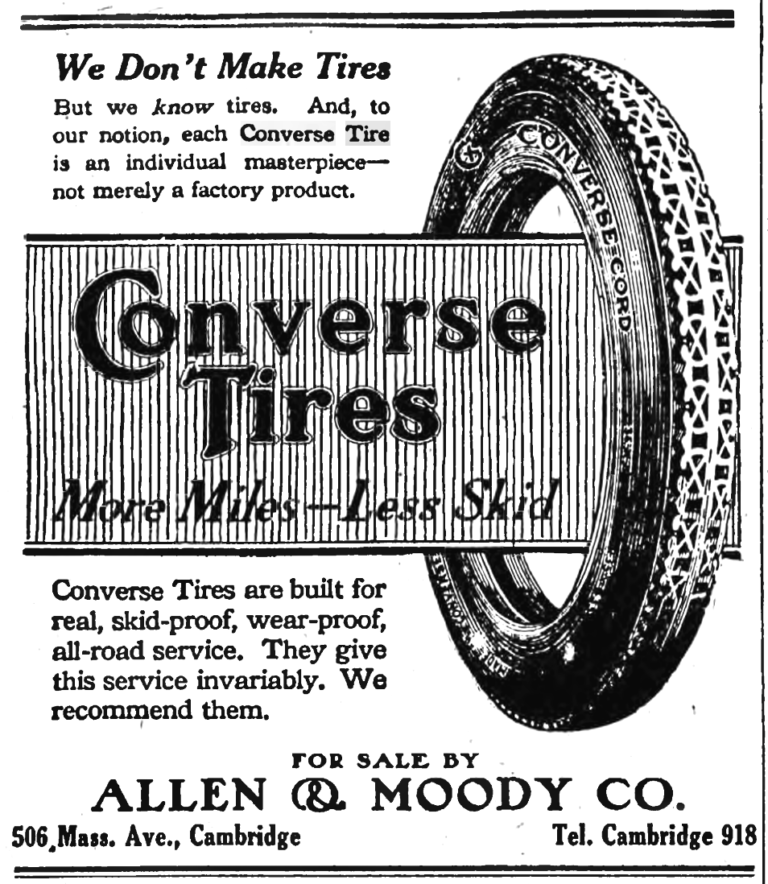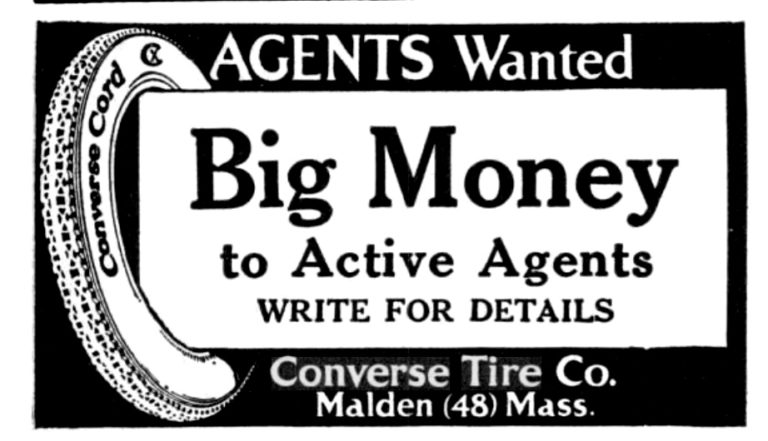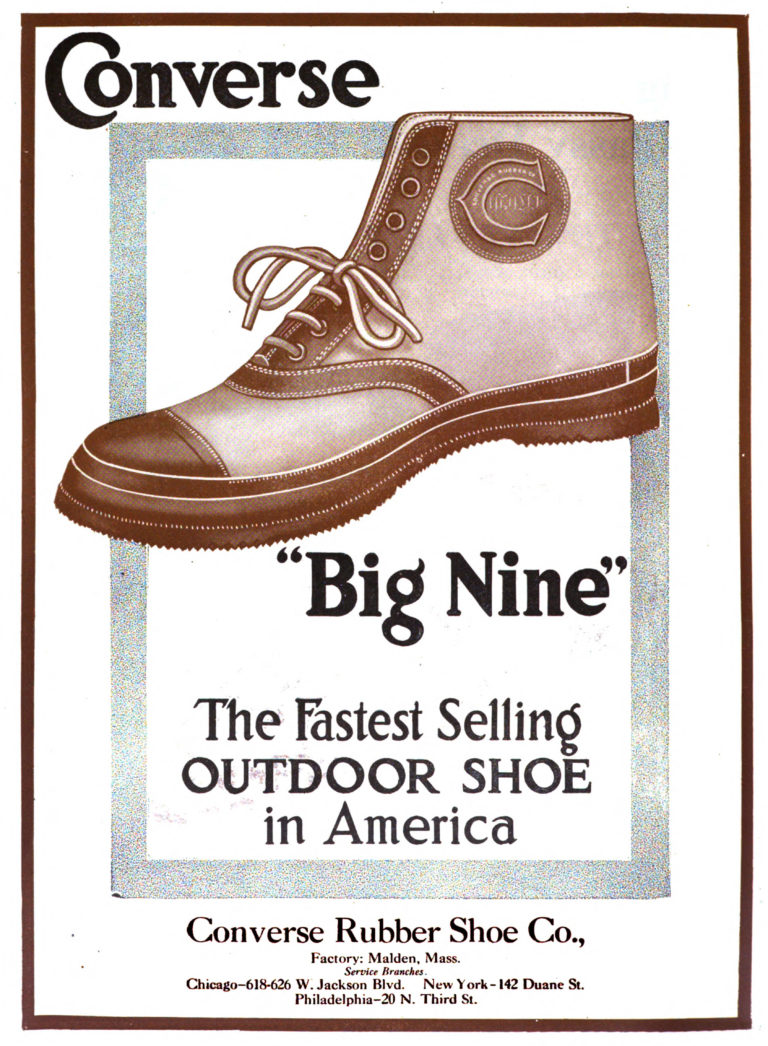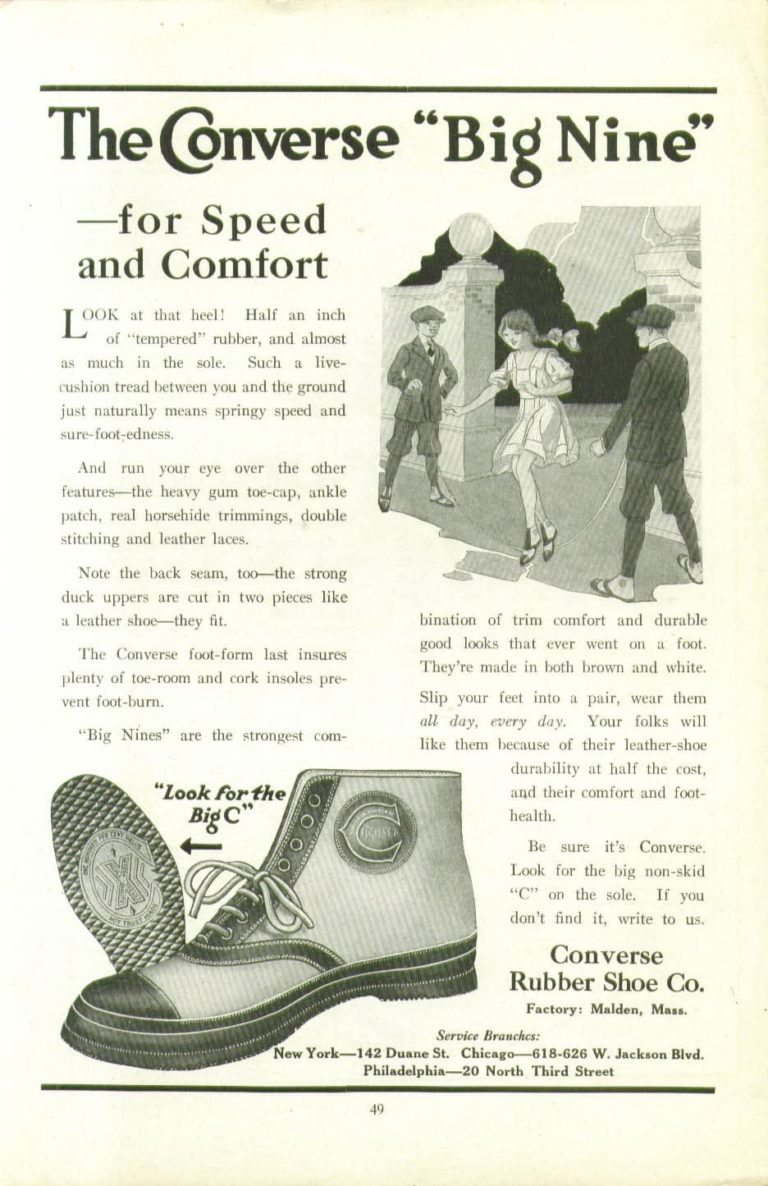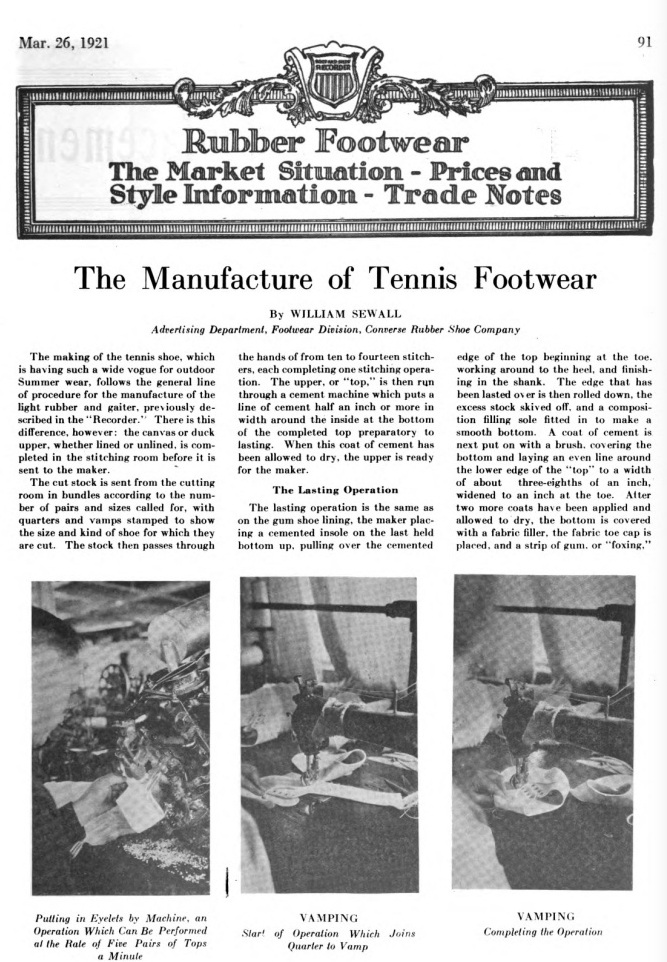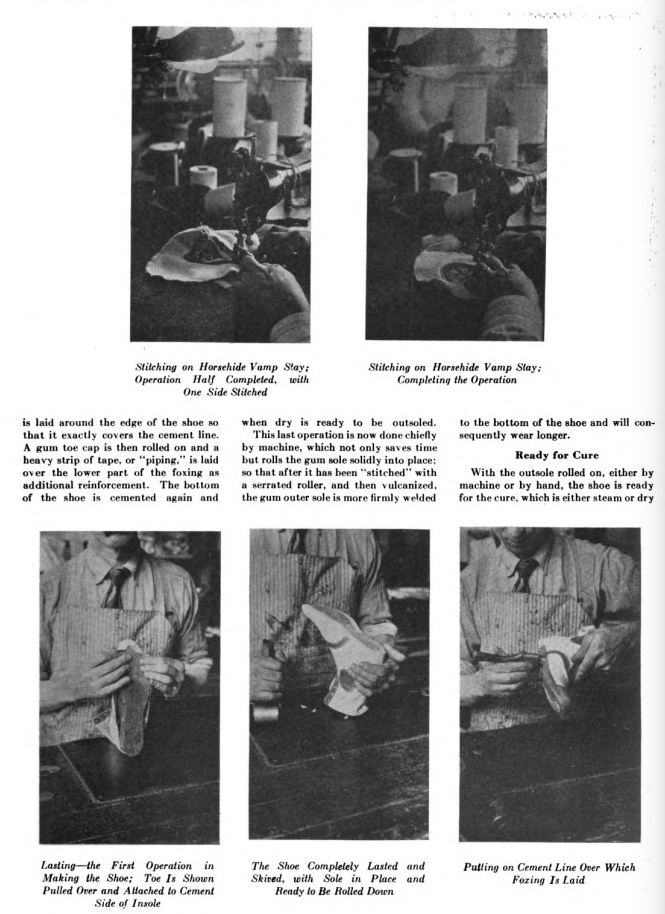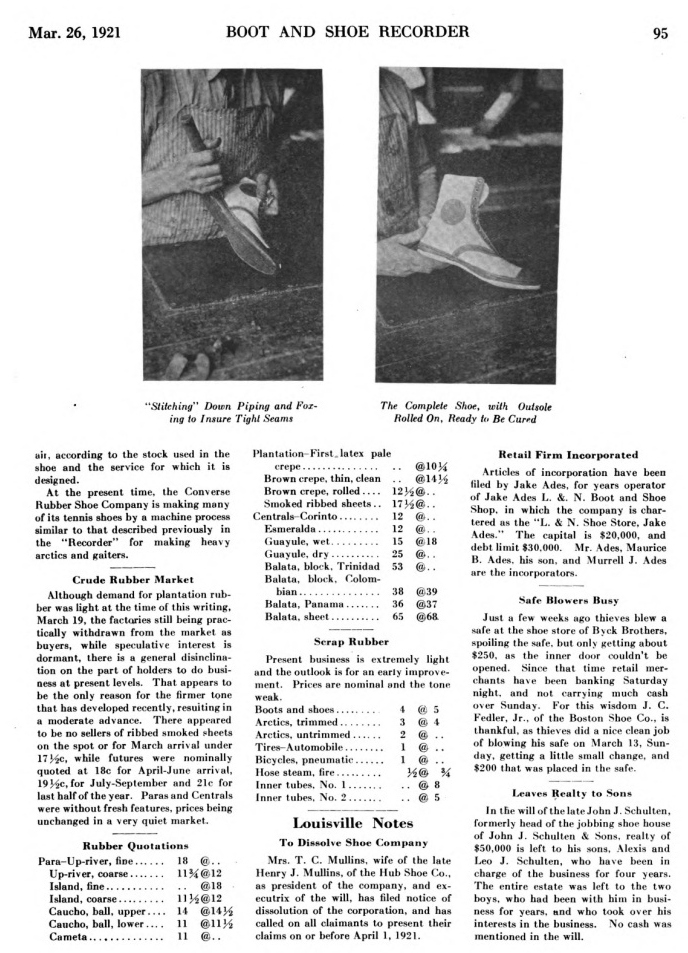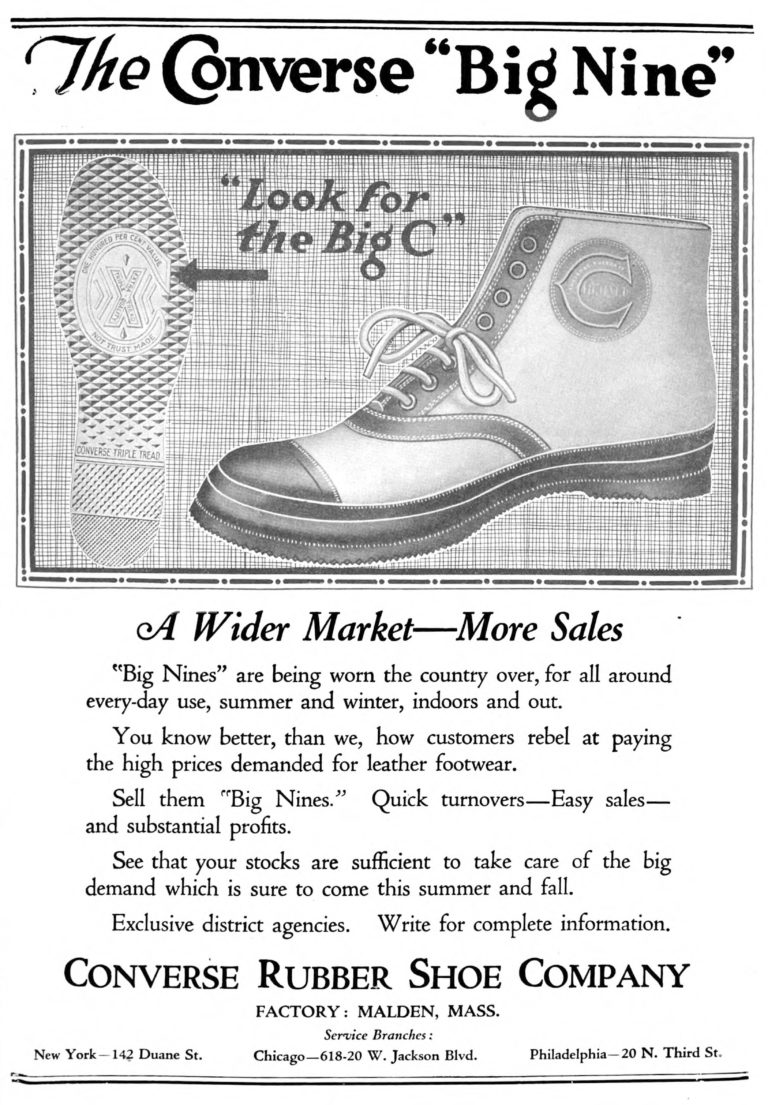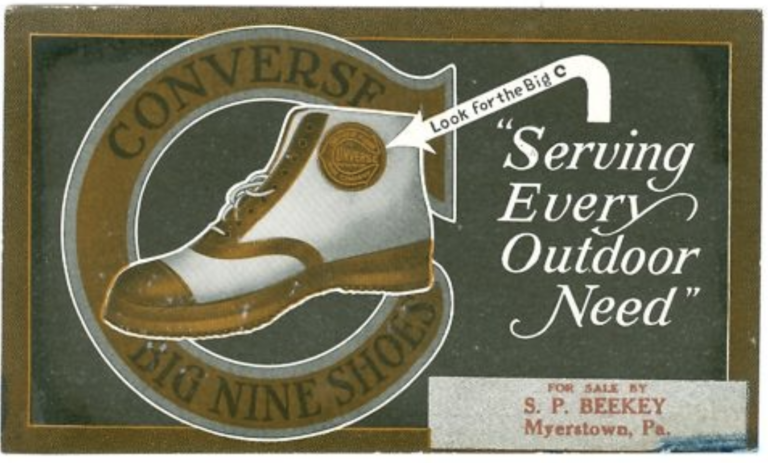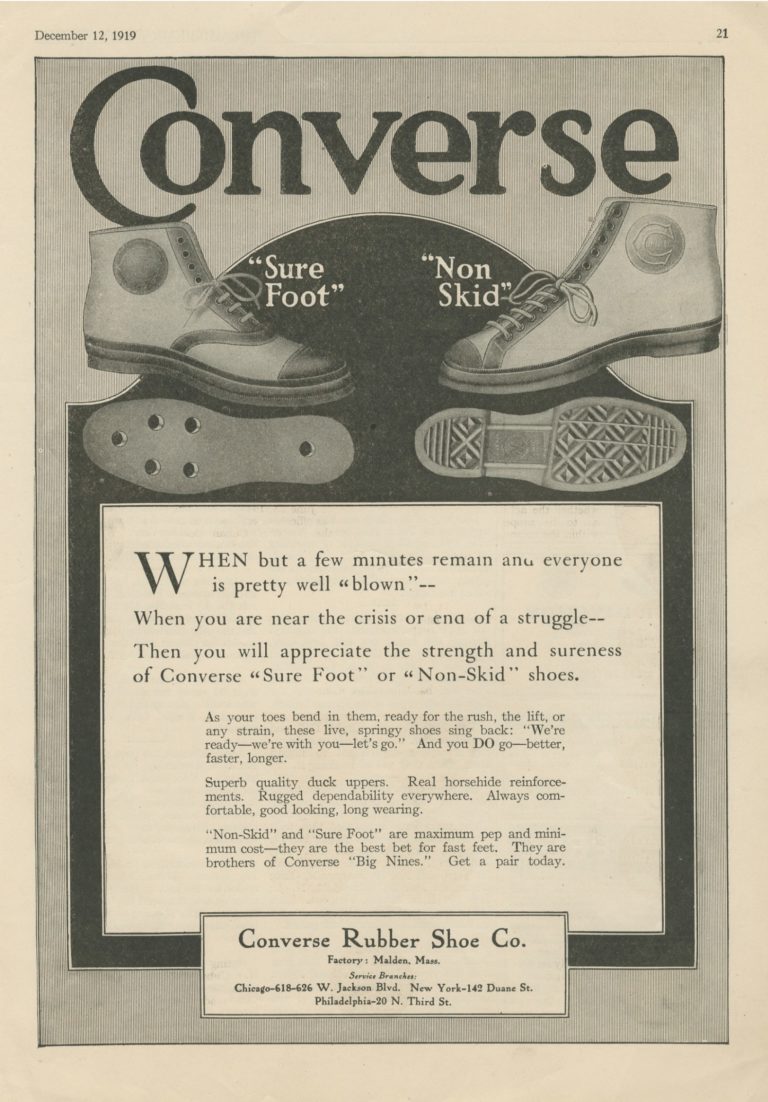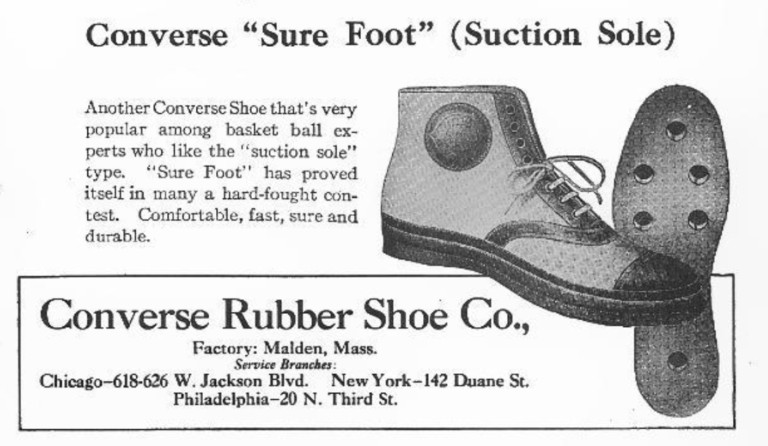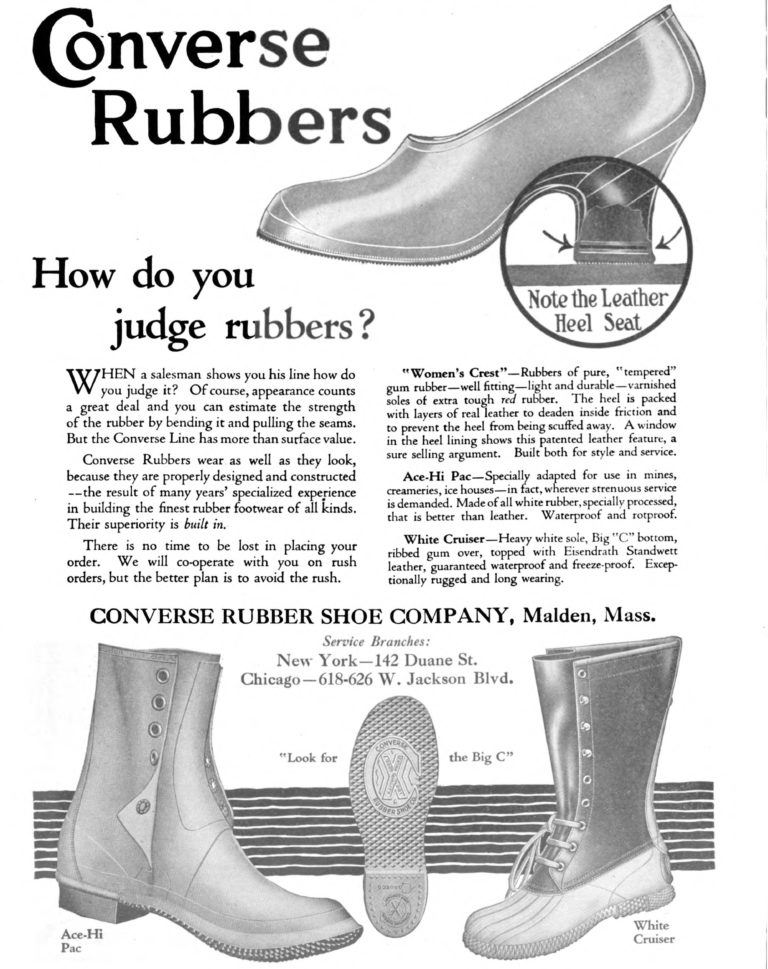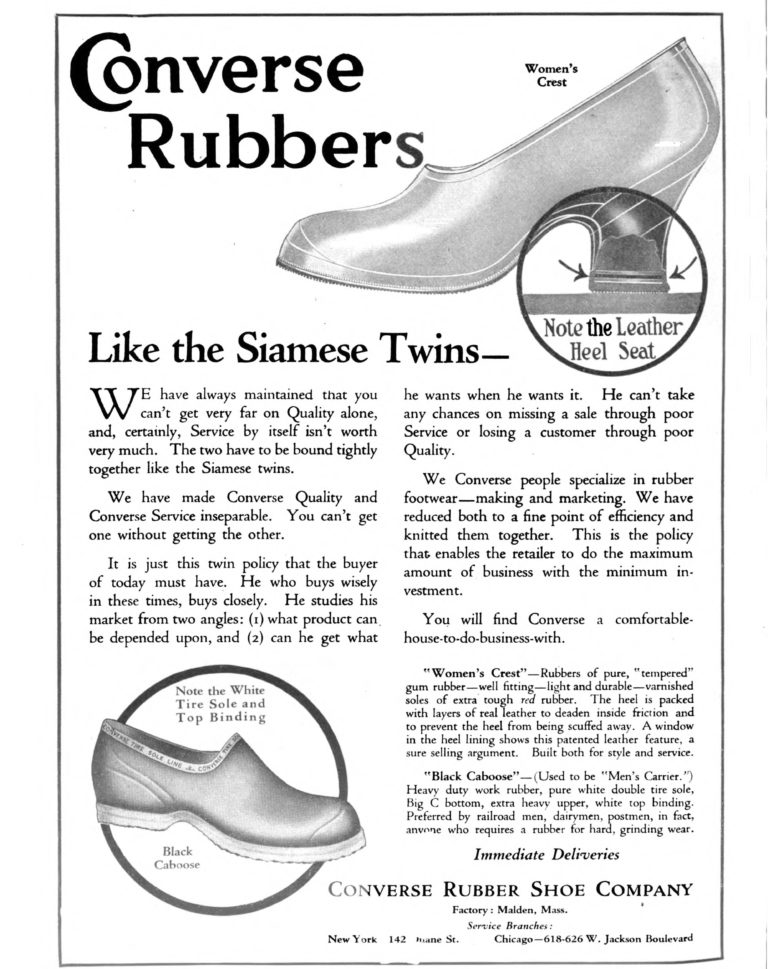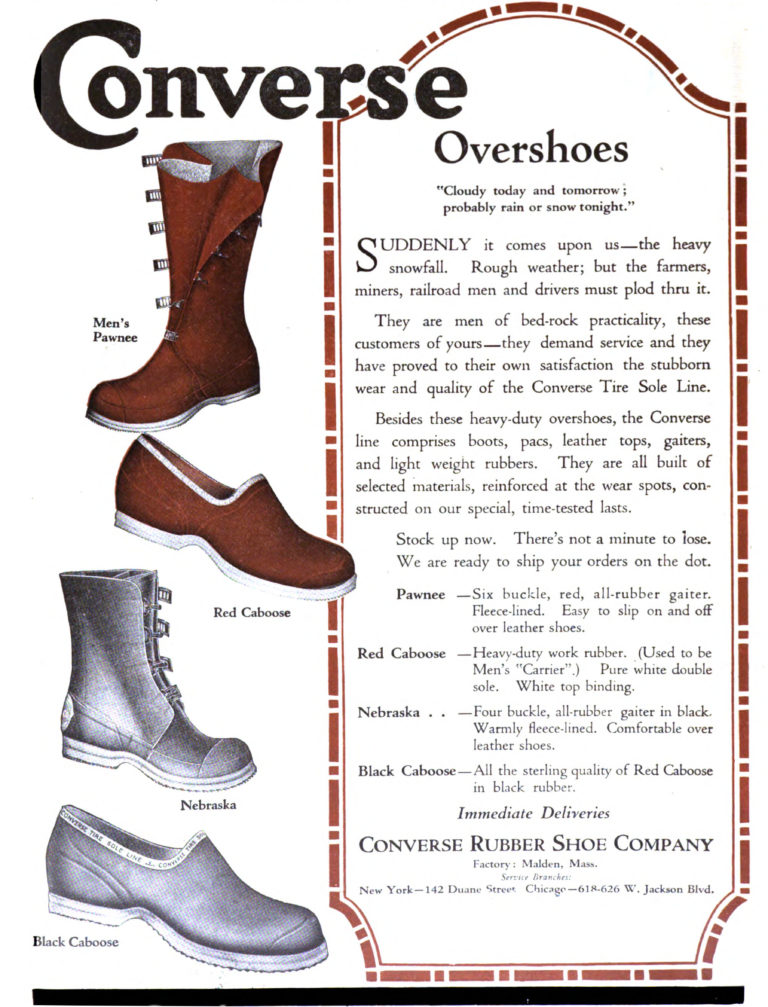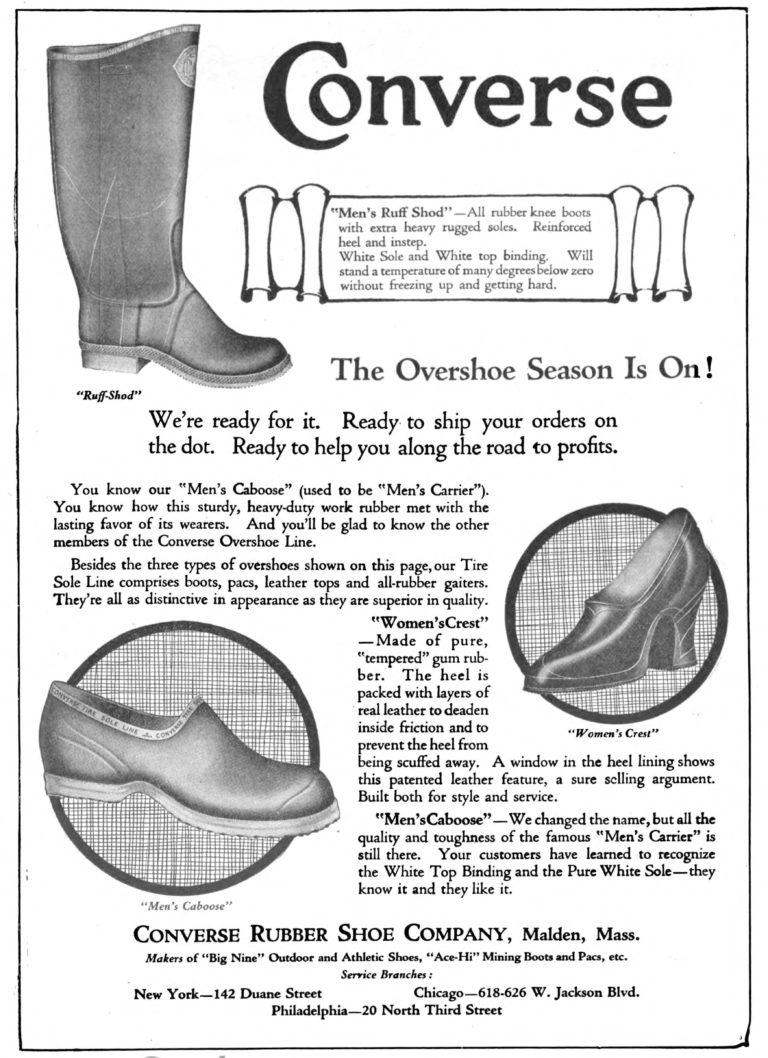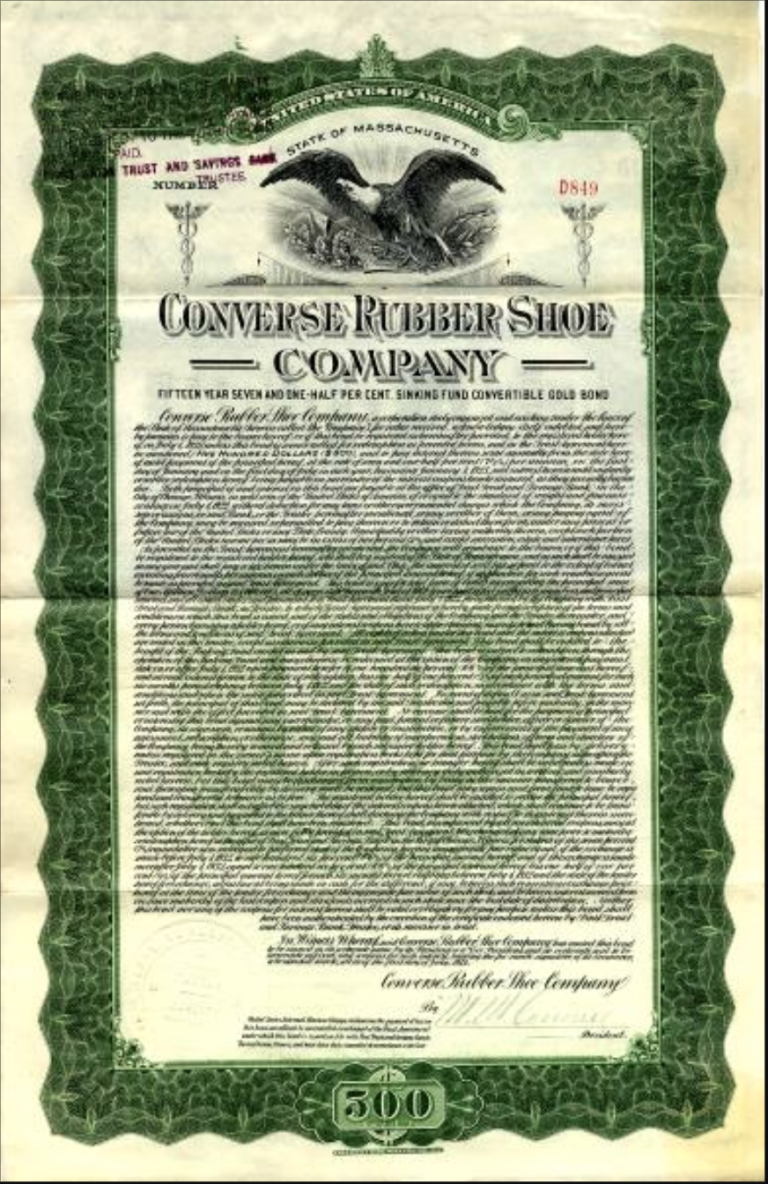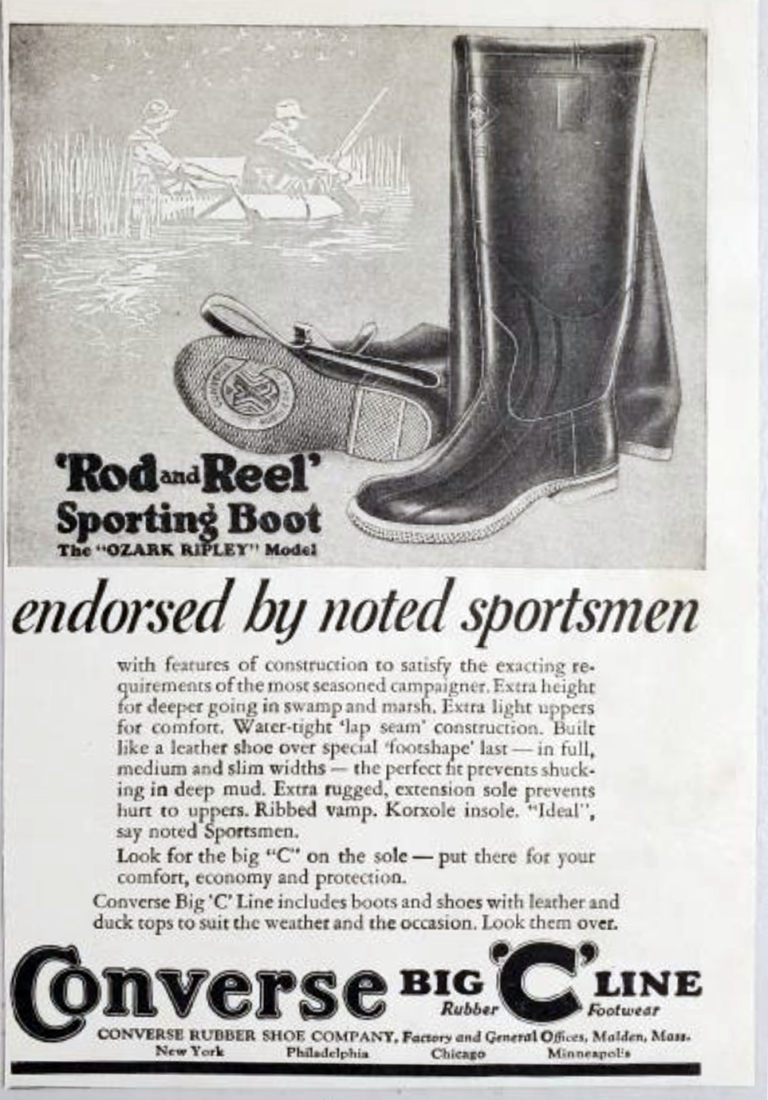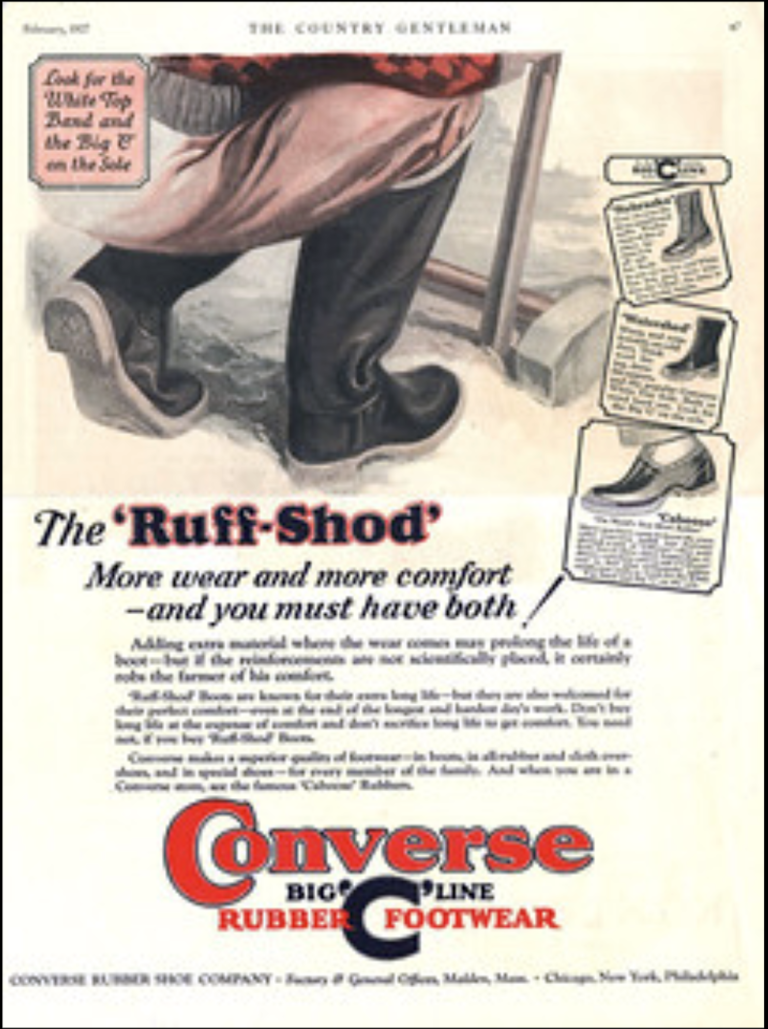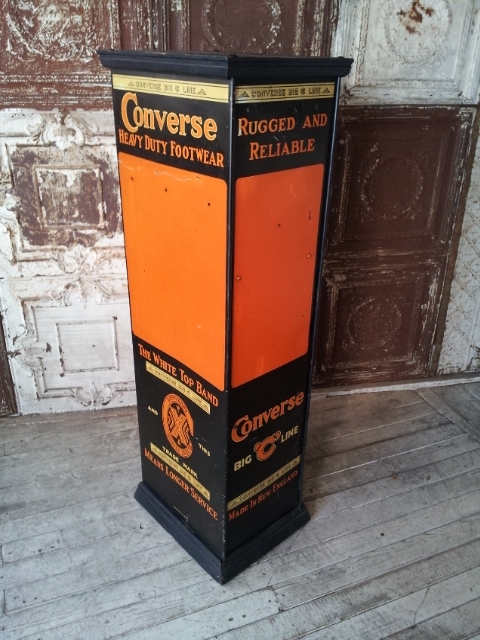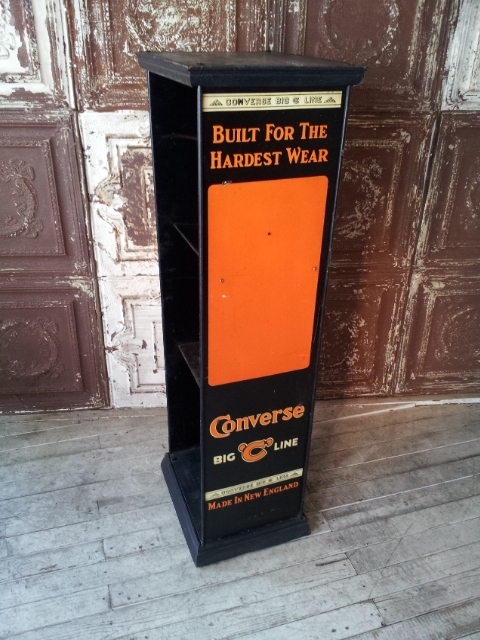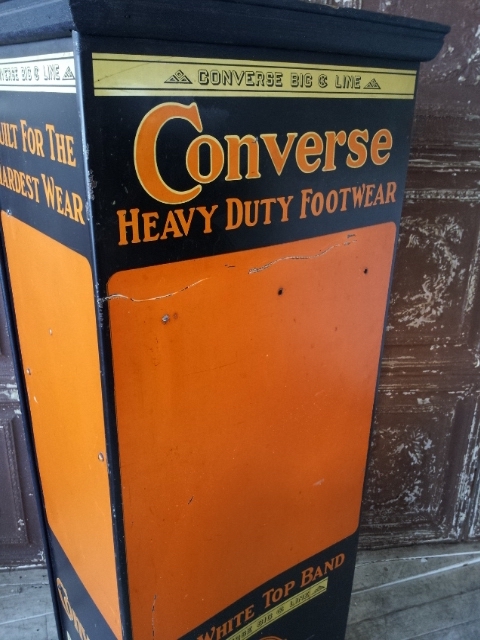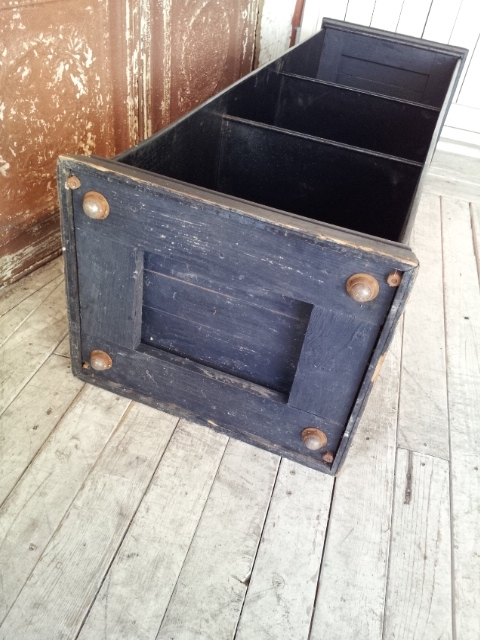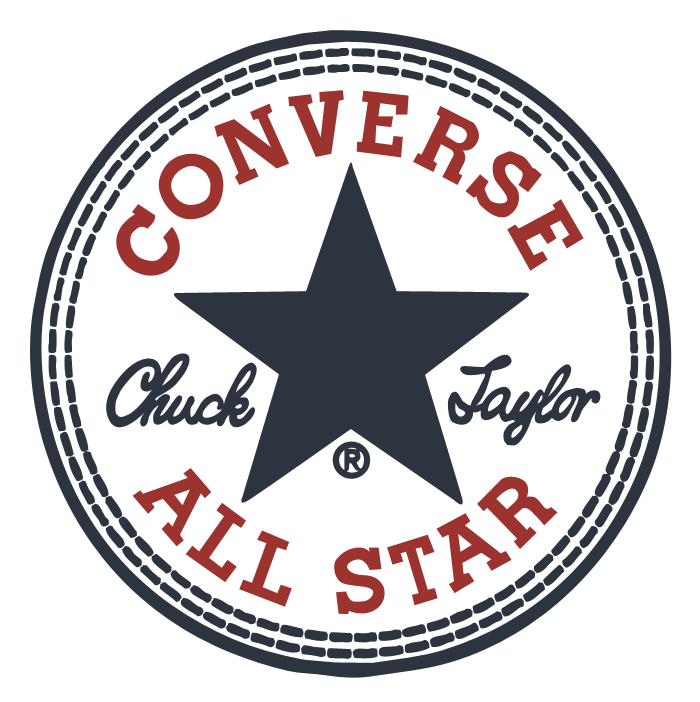
1900-1929
founder:Marquis Mills Converse


Marquis Mills Converse (1861-1931)
Founder of the Converse Rubber Shoe Company.
At age 47, Marquis Mills Converse, who was previously a manager at a footwear manufacturing firm, opened the Converse Rubber Shoe Company in February 1908 in Malden, Massachusetts. The company was a rubber shoe manufacturer, providing winterized rubber soled footwear for men, women, and children. By 1910, Converse was producing shoes daily, but it was not until 1915 that the company began manufacturing athletic shoes.
The company’s catalyst came in 1917 when the Converse All-Star basketball shoe was introduced. Then in 1923, a basketball player named Charles H. “Chuck” Taylor walked into Converse complaining of sore feet. Converse gave him a job: he worked as a salesman and ambassador, promoting the shoes around the U.S., and in 1932 Taylor’s signature was added to the All-Star patch on the classic, high-topped sneakers. He continued this work until shortly before his death in 1969. Converse also customized shoes for the New York Renaissance (the “Rens”), the first all–African American professional basketball team. In 1962, center Wilt Chamberlain of the Philadelphia Warriors scored 100 points in an NBA game while wearing a pair of Chucks, taking a 169–147 victory over the New York Knicks in Hershey, Pennsylvania on March 2.
コンバースラバーシューカンパニーの創業者。
47歳の時、それまで履物製造会社でマネージャーをしていたマーキス・ミルズ・コンバースは、1908年2月にマサチューセッツ州マルデンにコンバースラバーシューカンパニーを開業しました。同社はゴム製の靴メーカーで、男性、女性、子供向けに冬用のゴム底の靴を提供していました。1910年までに、コンバースは毎日靴を生産していたが、同社が運動靴の製造を始めたのは1915年までではなかった。会社の転機は、コンバースのオールスターバスケットボールシューズが発売された1917年に来ました。その後、1923年には、チャールズH. “チャック “テイラーという名前のバスケットボール選手が足の痛みを訴えてコンバースに入社しました。そして1932年、テイラーのサインがクラシックなハイトップスニーカーのオールスターパッチに追加されました。彼は1969年に亡くなる直前までこの仕事を続けました。コンバースはまた、ニューヨーク・ルネッサンス(”レンズ”)、最初のすべてのアフリカ系アメリカ人プロバスケットボールチームのために靴をカスタマイズしました。1962年には、フィラデルフィア・ウォリアーズのセンターウィルト・チェンバレンが、3月2日にペンシルバニア州ハーシーでニューヨーク・ニックスに169-147で勝利し、チャックスのペアを履いている間、NBAの試合で100点を記録しました。
ボストンの百貨店 ”Houghton and Dutton”で、6年間ゼネラルマネージャーとして働いた後 “Converse and Pike”で “WALES GOODYEAR RUBBER” という靴とラバーブーツの卸業をはじめ、これが大成功する。その後1900年に創業して間もない”Beacon Falls Rubber Shoe Company”のボストン店ストアマネージャーになる。[2] 1908年。自らの名前を会社名にした”THE CONVERSE RUBBER SHOE COMPANY”を会計士のJoseph S Capenと創業。[3] ラバーブーツの製造業はその品質の良さも手伝って順調に拡大していく。亡くなる2年前に「世界恐慌」が起こってしまい、コンバース社は1929年に倒産。その後営業権を譲渡する。健康上の理由で度々転職を繰り返したため、倒産直前には既に経営権が他人もしくは外部に譲っていた可能性も否定できない。
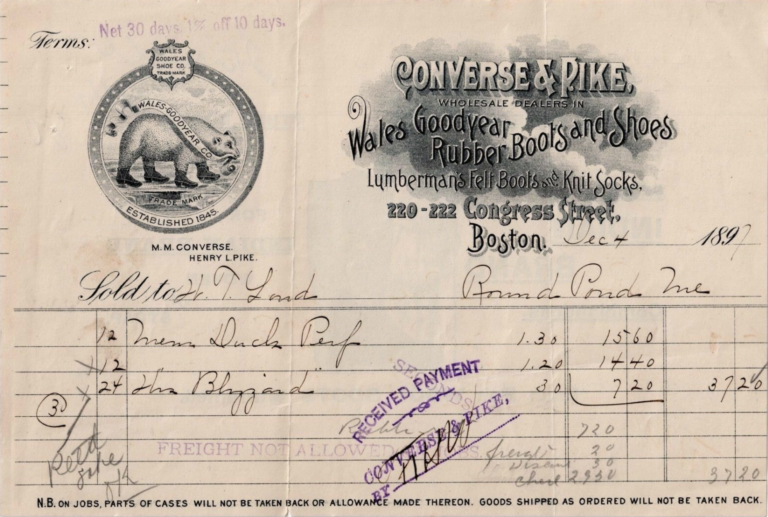

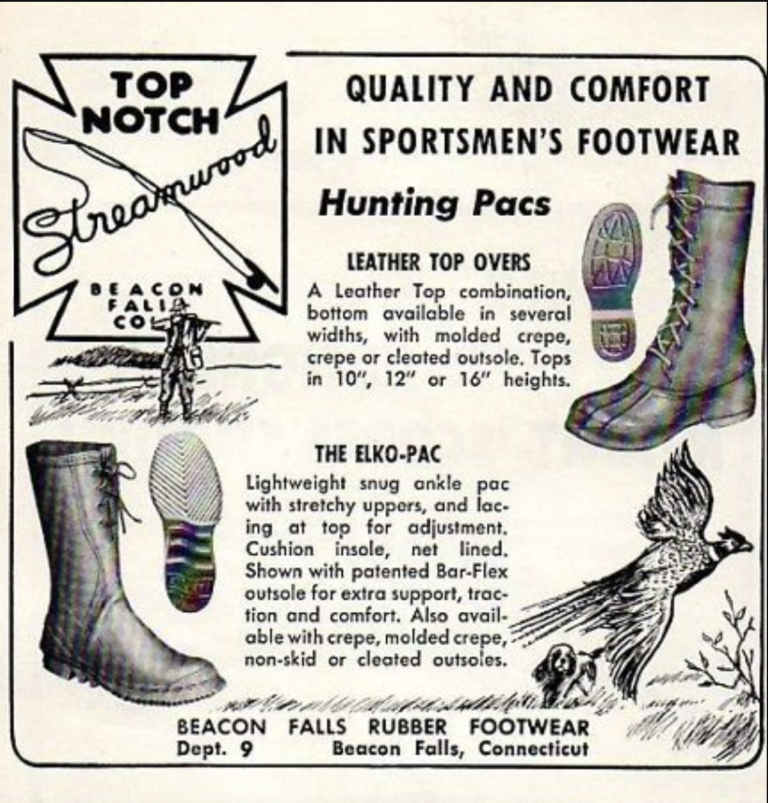
BEFORE ESTABLISHMENT
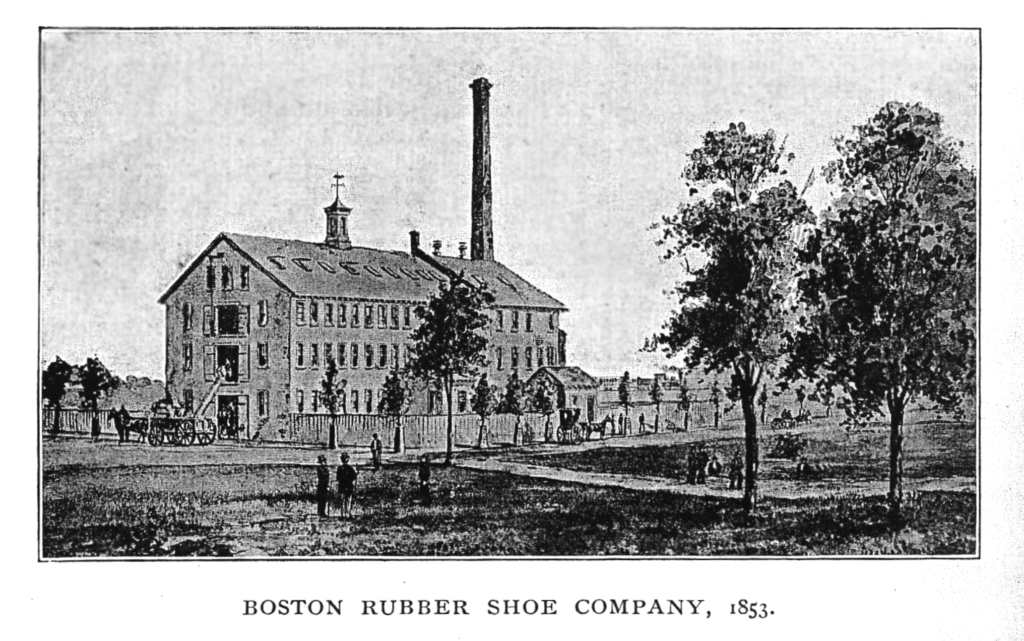
Charles Goodyear’s discovery of the vulcanization process led to the licensing of patents to a number of rubber factories, which in turn led to the establishment of many rubber manufacturers in the eastern United States, including those near Boston. This led to the establishment of many rubber manufacturers in the Boston area and other parts of the eastern United States.
1853. A relative of Marquis Converse, Elisha Slade Converse and his brother James form the BOSTON RUBBER SHOE COMPANY in Malden, Boston. The company manufactures winter slushers and rubber overshoes and grows to employ 3,500 workers, making it the largest employer in Malden. In recognition of his achievements, Elisha was elected as the first mayor of Malden in 1882. At the time, Marquis Converse was working as the general manager of one of Boston’s largest department stores. The success of his relatives led him to realize the great potential of the rubber industry, and he began working as a manager for the Beacon Falls Rubber Shoe Co. (KEDS), the fastest growing rubber company on the East Coast at the time, and he decided to start his own company.
It is possible that the Molden plant, which was the second plant in Beacon Falls, opposed the absorption into U.S. Rubber and became its own company.
チャールズ=グッドイヤーの加硫プロセスを発見以来、多くのゴム工場に特許のライセンスを提供することになる。その結果ボストン近郊をはじめ米国東部には多くのゴムメーカーが創業することになった。
1853年。マーキス=コンバースの親戚にあたる、エリシャスレイド=コンバースと兄ジェームズはボストンのモールデンにBOSTON RUBBER SHOE COMPANYを結成。同社は冬のスラッシュ用ゴム靴、ゴムオーバーシューズを製造する。3,500人もの従業員を抱えるまでに成長し、モールデンで最大の雇用先となった。その功績も認められ1882年エリシャはモールデンの最初の市長に選出される。当時、マーキス=コンバースはボストン最大手の百貨店にてゼネラルマネージャーとして働いていた。その親戚の成功をふまえゴム産業の大きな可能性を感じた彼は、ビーコンフォールズラバーカンパニー(Beacon Falls Rubber Shoe Co.)でマネージャーとして働き始めることになる。そこが当時東海岸では最も勢いのあったU.S.ラバー社 (KEDS) に吸収されることになると彼は自分の会社を始めることにした。
※ビーコンフォールズの第二工場だったモルデンの工場がUSラバーへの吸収に反対して独立した可能性もある。
BOSTON RUBBER SHOE COMPANY
At its start, the Boston Rubber Shoe Company used the newly discovered vulcanized rubber to make just a few kinds of footwear. Their first factory, in nearby Malden, grew to employ 1,500 workers producing 20,000 pairs of shoes each day. Even this tremendous output, however, could not keep up with demand, so a second factory was built in 1883 on Washington Street in Melrose. This second site would employ 1,200 workers turning out an additional 12,000 pairs of shoes each day. Additional buildings were added to the mill complex in the 1890s, including 37 Washington Street. By 1893, the factories were producing 40,000 pairs of shoes each day in over 1,500 styles, shapes, and widths. In one nine-year period, the company produced nearly twelve million pairs of their most popular “Storm Slipper”. Shoes from Malden and Melrose were sold all over the country and around the world.
The Boston Rubber Shoe Company became the largest employer in Melrose and was largely responsible for the transformation of the city from a farming community to one with an industrial-residential character, as farms were sold and developed into housing lots for factory workers. Residents of Melrose and surrounding towns were employed at the factory until the plant was finally closed, and operations returned to Malden, in 1929.
Measuring 195 feet long by 86 feet deep, and featuring a small accessory structure attached to the north face, the 37 Washington Street building at the Boston Rubber Shoe Company stood on a lot of just over two and one-quarter acres and was four stories of classic wood beam and brick façade construction. The ground floor featured a number of truck-height loading docks. Windows in the building were multi-paned and plentiful, sills were a neat granite, and the roof was tar and gravel. A majority of the beams in the building were slow-growth longleaf pine, also known as Heart Pine.
ボストン・ラバー・シュー・カンパニーは創業当初、新たに発見された加硫ゴムを使用して数種類の靴を製造していました。近くのマルデンにあった最初の工場は、1,500人の従業員を雇用し、毎日20,000足の靴を生産するまでに成長しました。しかし、この驚異的な生産量でも需要に追いつくことができず、1883年にメルローズのワシントン・ストリートに第2工場が建設されました。この第2工場では1,200人の従業員が毎日12,000足の靴を生産していました。1890年代には、ワシントンストリート37番地など、工場の複合施設に追加の建物が建設されました。1893年までには、工場は1,500以上のスタイル、形、幅で毎日40,000足の靴を生産していました。9年間で、最も人気のある「ストーム・スリッパ」を1,200万足近く生産した。マルデンとメルローズの靴は、国内はもちろん、世界中で販売されました。
ボストン・ラバー・シュー・カンパニーはメルローズの最大の雇用主となり、農場が売却され、工場労働者のための住宅地として開発されたことで、メルローズの農業地域から工業的な住宅地への変貌に大きく貢献しました。メルローズとその周辺の町の住民は、工場が最終的に閉鎖され、1929年に操業がマルデンに戻るまで、工場で雇用されていました。
ボストンゴム靴会社のワシントン通り37番地の建物は、長さ195フィート、奥行き86フィートで、北側の面に小さな付属構造物が取り付けられていました。1階にはトラックの高さの荷台がいくつもありました。建物の窓は複数の窓からなり、窓枠は花崗岩で、屋根はタールと砂利で覆われていました。建物の梁の大部分は、ハートパインとしても知られている成長の遅いロングリーフパインでした。
1908:ESTABLISHMENT
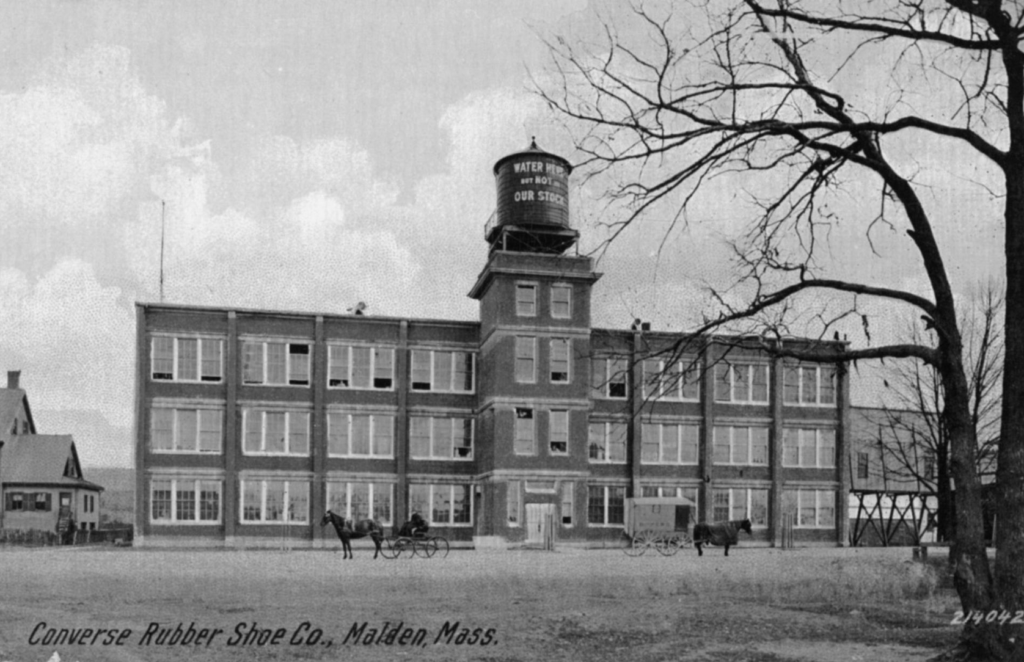
The Converse Rubber Shoe Company of Malden, whose new factory is now under construction, has secured a temporary office at 612 Atlantic avenue where President M. M. Converse and Treasurer J. C. Capen will be in attendance to welcome the visiting buyers. Besides these two officers, the store force at present consists of John E. Folan. B. J. Borns, W. H, Patrick and F. E. Harriman, all of whom are well known to the boot and shoe trade of New Englandand the Middle States.
– Shoe retailer and boots and shoes weekly. v. 67-68 (1908).
– Boot and shoe recorder v. 54 (Jan.-Feb. 1909).
The Converse Rubber Shoe Company’s factory at Malden is now running to full capacity. This new company has proved that there is a good market for the lines which they manufacture. Besides rubber footwear, the company is now manufacturing the Cant-Slip Rubber Heel, for which several advantages are claimed over all other rubber
— Boot and shoe recorder v. 55 (Aug. 18-Sept. 22, 1909).
– Boot and shoe recorder v. 61 (Apr.-May 1912).
新工場が建設中のモルデンのコンバースラバーシューカンパニーは、アトランティックアベニュー612番地に仮事務所を確保し、社長のM.M.コンバースと会計係のJ.C.ケイペンが出席してバイヤーを歓迎します。この2人の役員の他に、現在の店舗スタッフは、John E. Folan、B. J. Borns、W. C. Capen、B. J. J. Borns、B. J. Borns、W. C. Capenの4名で構成されています。B.J.ボーンズ、W.H.パトリックとF.E.ハリマン、すべての人は、ニューイングランドと中米のブーツや靴の貿易によく知られています。
その新しい工場は現在建設中であるマルデンのコンバースゴム靴会社は、社長M.M.コンバースと会計J.C.ケイペンが訪問バイヤーを歓迎するために出席しますアトランティックアベニュー612で一時的なオフィスを確保しています。 B.J.ボーンズ、W.H.パトリックとF.E.ハリマン、すべての人は、ニューイングランドと中米のブーツと靴の貿易によく知られています。
マルデンにあるコンバースゴム靴会社の工場は、現在フル稼働しています。この新しい会社は、彼らが製造する製品には良い市場があることを証明しました。ゴム製の靴のほかに、同社は現在、いくつかの利点は、他のすべてのゴム製の上に主張されているため、カント-スリップラバーヒールを製造している
1908年11月17日。マサチューセッツ州モールデンでマーキス・M・コンバースが創業。マーキス=コンバースは250,000ドルの設備投資と15人の従業員で新工場を始める。降雪量の多いマサチューセッツ州の湿地帯などでも使用可能な高性能ラバーシューズを製造。1910年には350名まで増員、ゴムブーツとシューズを日産4000足まで増産する。


1910-14
– Boot and shoe recorder v. 61 (Apr.-May 1912).
The Converse Rubber Shoe Company has been awarded a contract for furnishing the United States Navy Department with 1,200 pairs of arctics.
– Boot and shoe recorder v. 66 Oct 10 1914 (Oct.-Nov. 1914).
The Converse Rubber Shoe Company reports its business last season triple that of previous year, and prospects for as good a showing the coming year. Present ticket is 7,000 pairs :1 day, which is 1,000 more than at any previous season.
– Boot and shoe recorder v. 66 Oct 14 1914 (Oct.-Nov. 1914).
Converse Rubber Shoe Co.Malden, Mass.
There is no doubt but that the shoe retailer has had two serious obstacles to overcome in the way of holding his business to normal, to say nothing of an increase the past year.
First: Very unseasonable weather conditions, both spring and fall.
Second: Smaller pay rolls from manufacturing industries, which means less producing power.
No one can correctly prophesy an improvement in weather conditions, but it is a foregone conclusion that many industries that have been running on part time the past year will be running full in the near future, in fact some are running a night shift now.
With Europe depending on the United States largely for finished product, this’ country is bound to see an era of great prosperity, and the retailer of shoes is bound to get a corresponding benefit.
– Boot and shoe recorder v. 66 Dec 12 1914 (Dec. 1914-Jan. 1915).

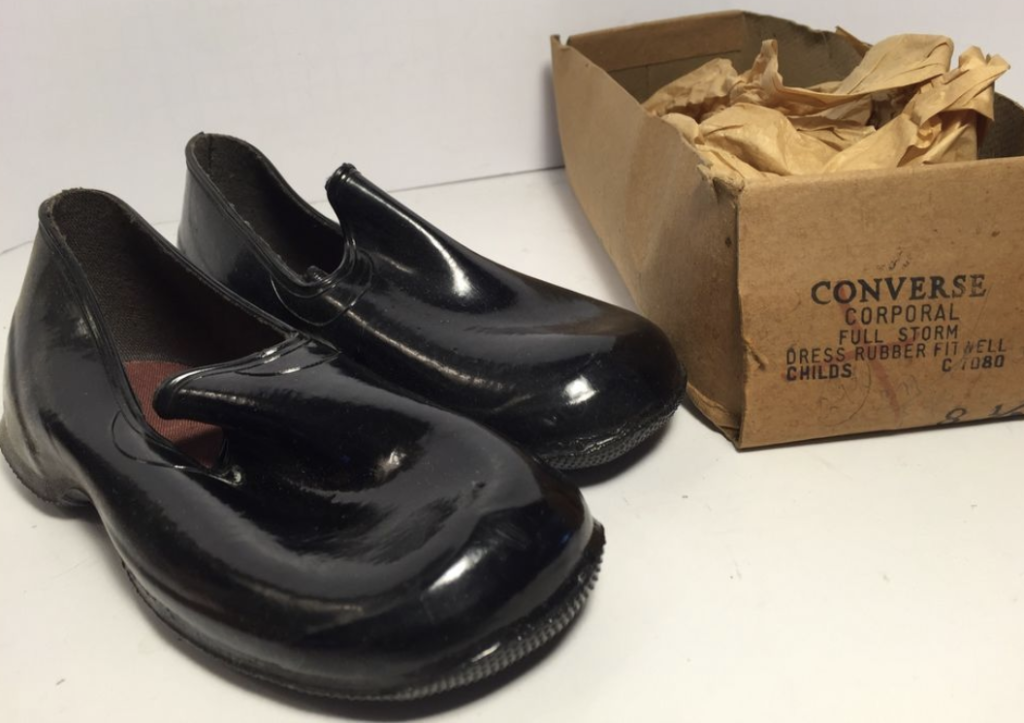

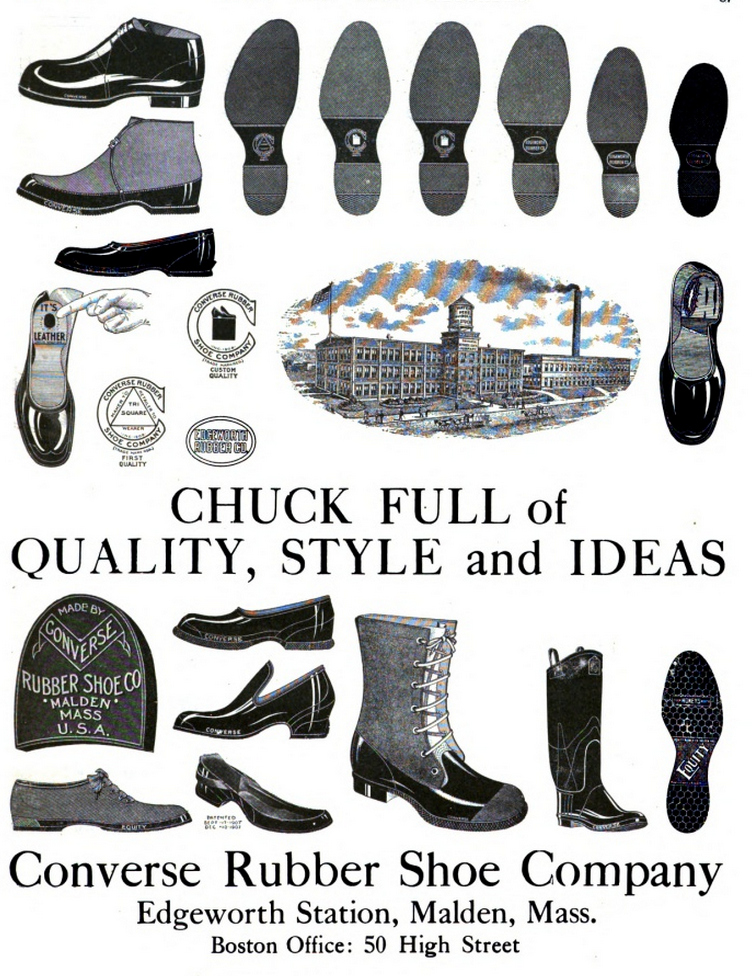
1911年の広告。ラバーブーツなどと共にテニスシューズの製造が見受けられる。
Boot and shoe recorder v. 59 (Aug.-Sept. 1911).

端にCX=Big”C”マークが入っているので1916年以降。男子が履いているのがBIG NINEの可能性が高いので1917年以降の看板。1919年以降の可能性も高い
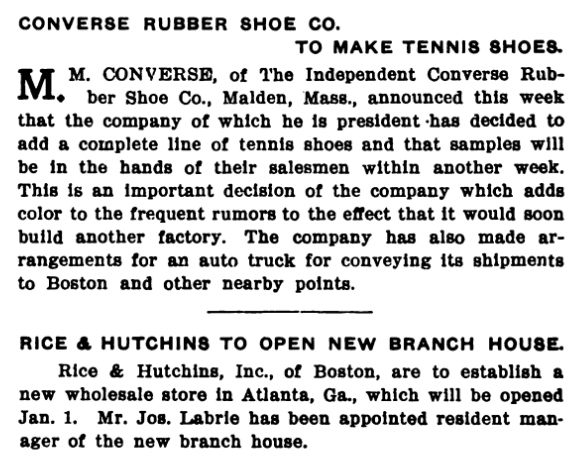
テニス用のシューズはすでに1909年から製造されはじめている。
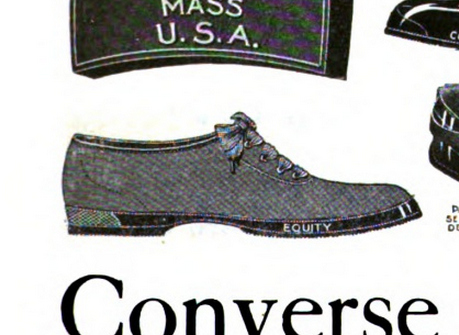
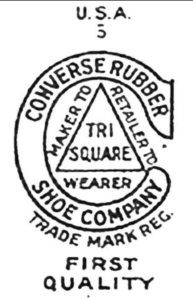
端にCX=Big”C”マークが入っているので1916年以降。男子が履いているのがBIG NINEの可能性が高いので1917年以降の看板。1919年以降の可能性も高い
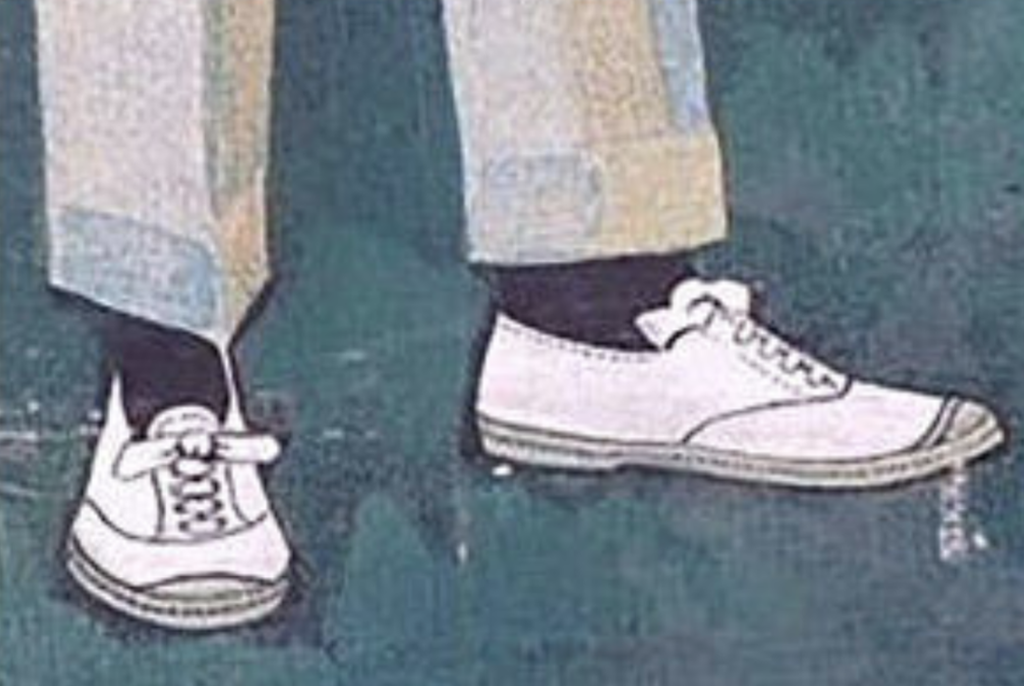
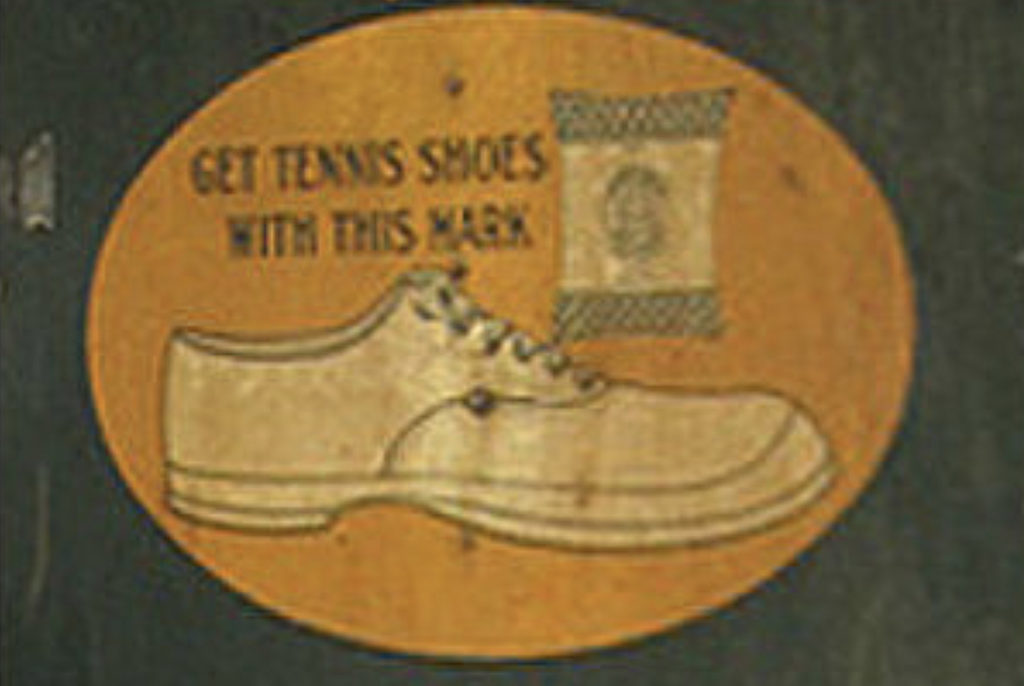
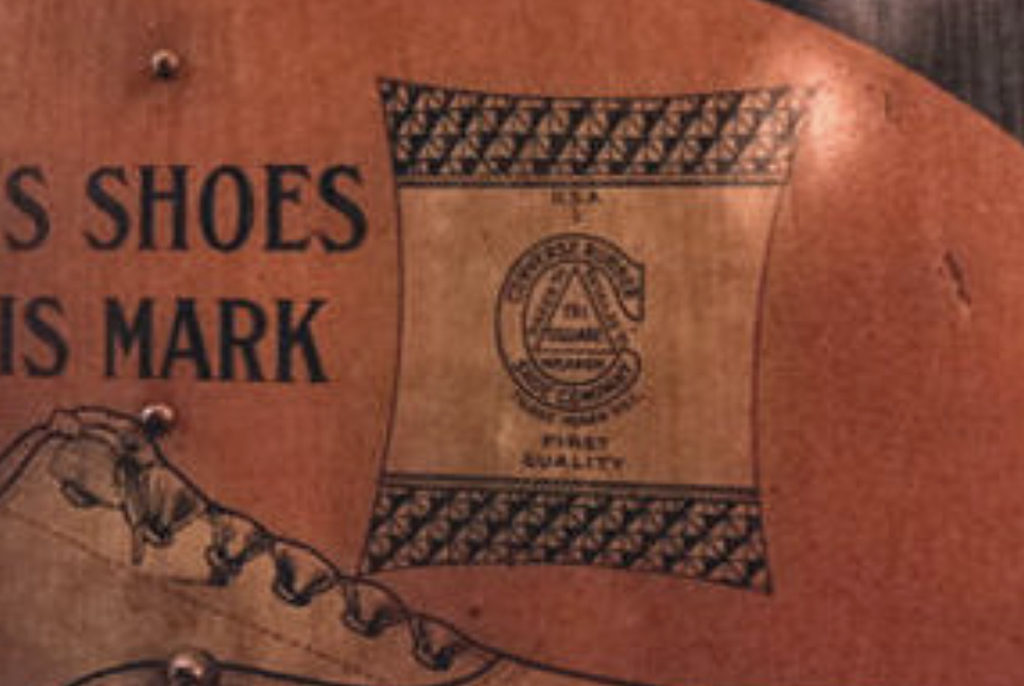
1915年(1913年ごろとも言われている)。春夏に需要が落ちるラバーシューズの穴を埋めるためにテニスシューズを製造開始。売り上げが倍増する。これがコンバース初のスポーツ用シューズになる。先行メーカーの KEDSやSPALDINGのテニスシューズに酷似している。内バネのスタイルはこの時代のスポーツシューズデザインの流れ。この年には、新興勢力としてライバル関係にあったタイヤ製造のファイヤストーン社がシューズ工場を買収しスポーツシューズを生産始めたことに対抗し、自動車用タイヤ (CONVERSE TIRES) の生産始める。
1915-19
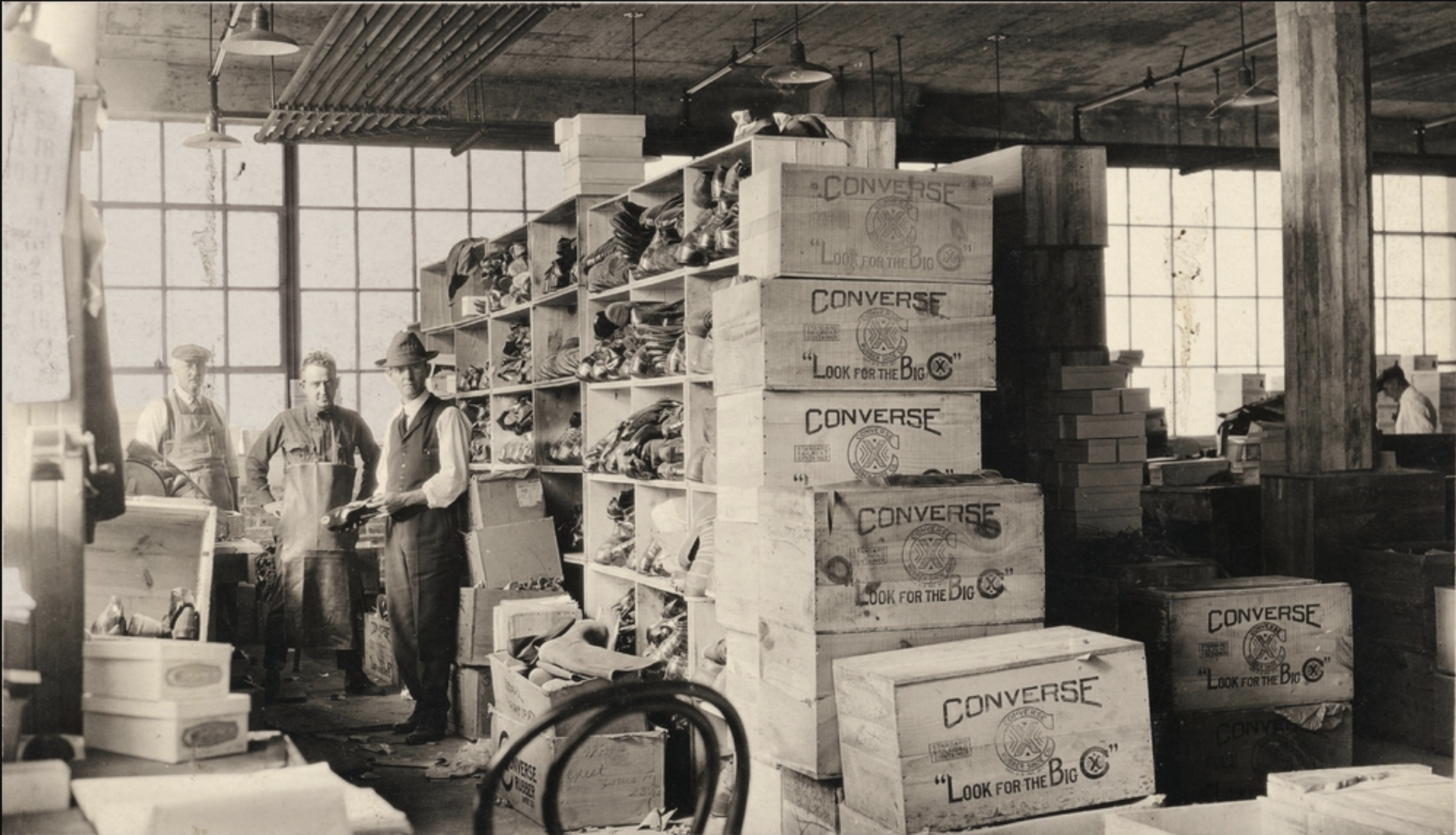
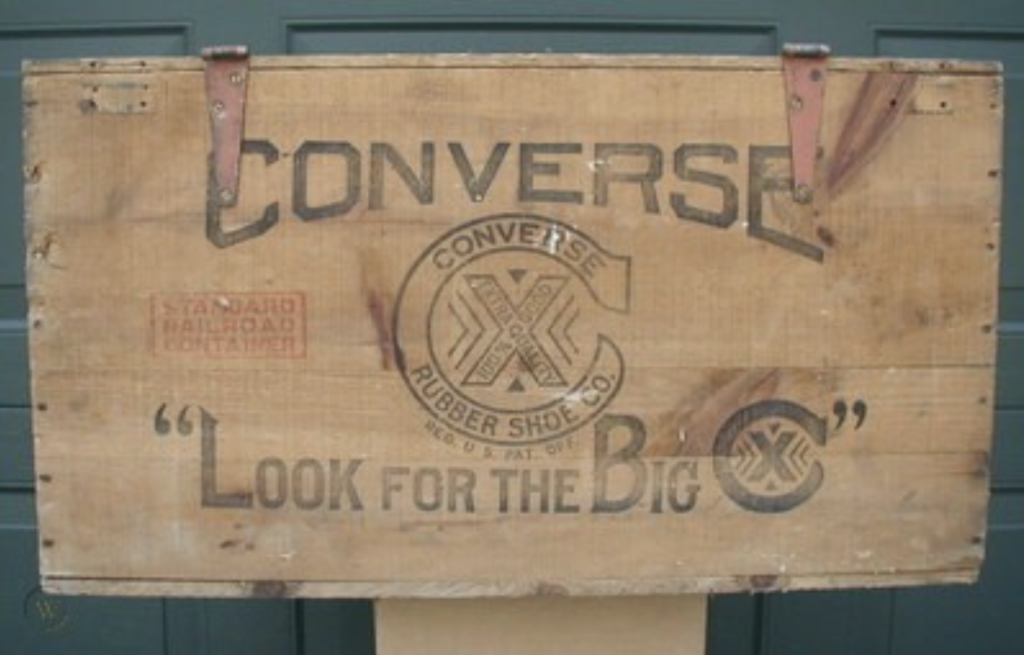
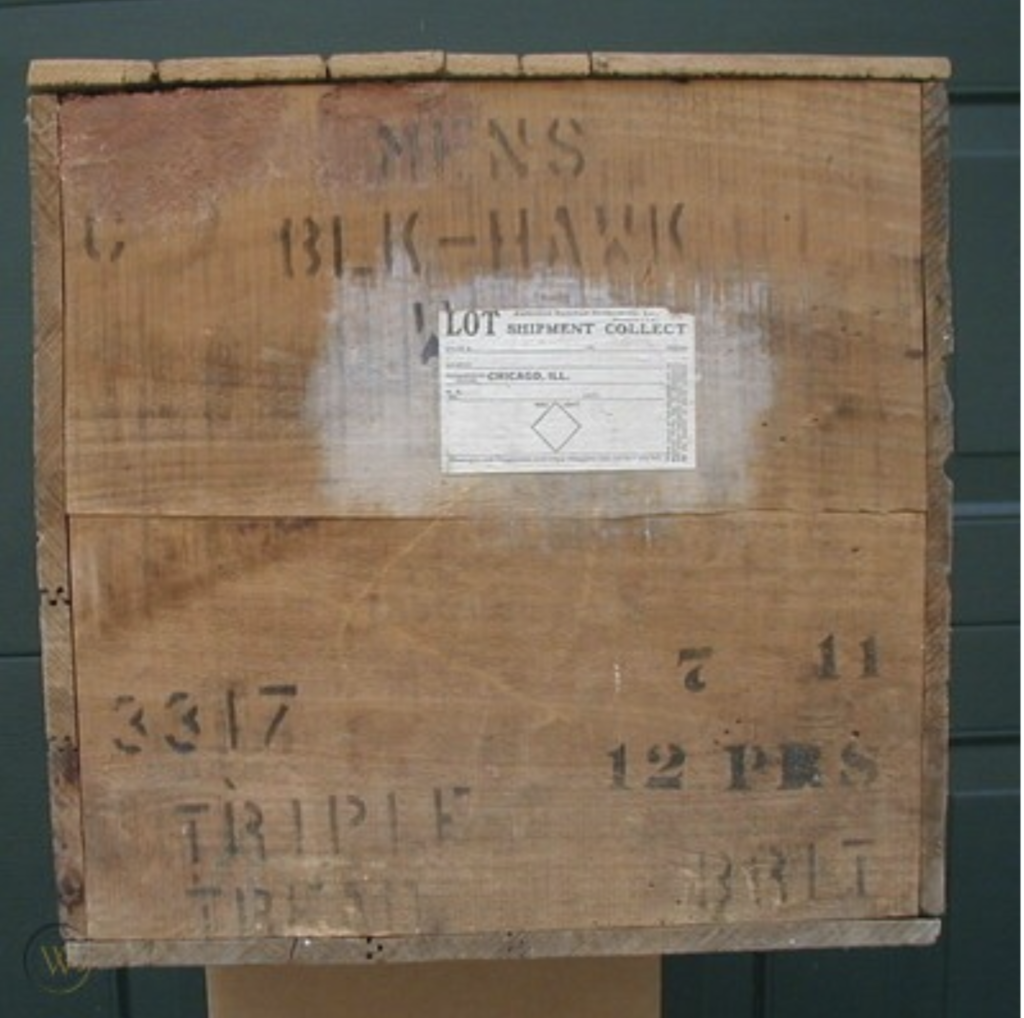

“Look For The Big C “の記載から1910年後半から1920年前半あたりの工場の様子と推測される。
CONVERSE RUBBER SHOE CO. WOOD STANDARD RAILROAD CONTAINER BOX CRATE 26″X16″X15′
The firm of Niles & Goodell, which is the distributing
agency for this territory for the Converse Rubber Shoe Co., has been incorporated without change of name, save the adding of the word, “Incorporated,” with Frank R. Goodell, president, Chas W. Niles, vice president and treasurer, and H. M. Alexander, secretary. They have moved into new quarters at I42 Duane Street, the building formerly occupied by the Amsterdam Rubber Co., where they have a ground floor office and salesroom, and much more space for the carrying of stock.
– Boot and shoe recorder v. 66 Apr 24 1915 (Dec. 1914-Jan. 1915).
The Converse Rubber Shoe Co. of Malden, Mass., has increased its capital to $700,000. At the annual business meeting last month the following officers were reelected. M. M. Converse, president; H. L. Doliff, secretary, Hugh Bul lock, treasurer and H. C. Arnold, assistant superintendent. The company has brought suit against the Boston and Maine Railroad for $300,000 for fire damage to its factory and plant, alleging the cause to be a spark from a passing loco motive.
– Boot and shoe recorder v. 67 Jun 5 1915 (June-July 1915).
-Boot and shoe recorder v. 68 Jan 8 1916 (Dec. 1915-Jan. 1916).
-Boot and shoe recorder v. 68 (Feb.-Mar. 1916).
– Boot and shoe recorder v. 68 (Feb.-Mar. 1916).
– Boot and shoe recorder v. 69 Apl 15 1916 (Apr.-May 1916).
– Boot and shoe recorder v. 69 Jun 3 1916 (June-July 1916).
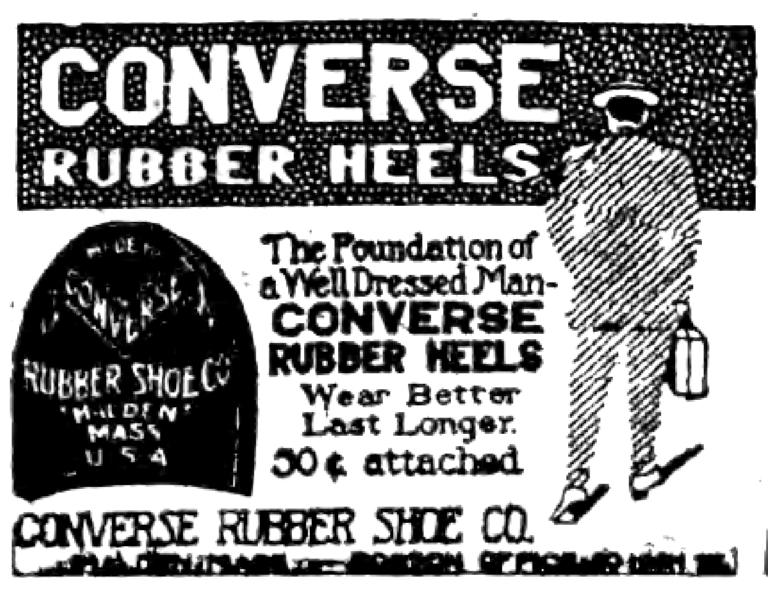
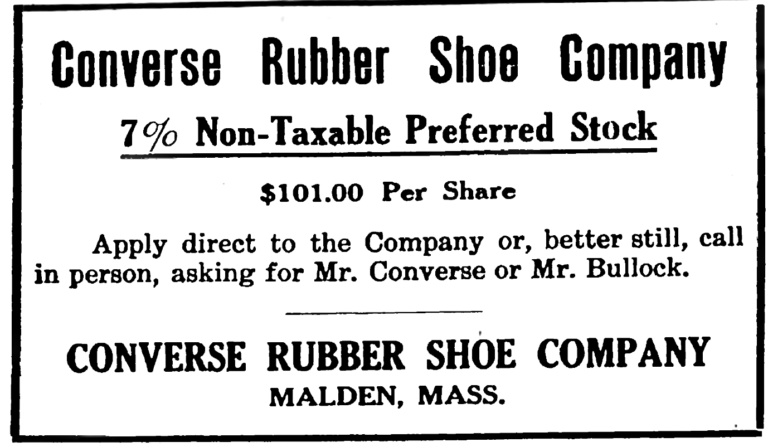
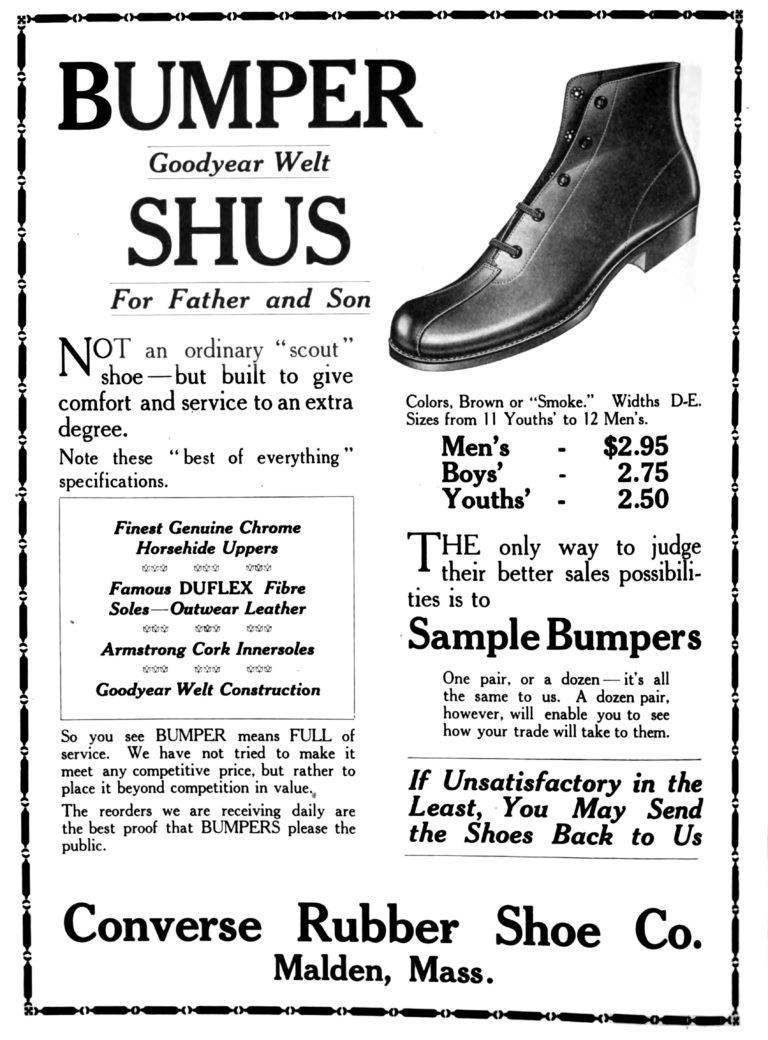
The Converse Rubber Shoe Co. of Malden has in sured every one of the workers in its employ to a sub stantial amount, the company paying the premiums. This is another instance of the interest the officers of this company are taking in their employees.
モルデンのコンバース・ラバー・シュー社は、従業員全員に多額以下の保険をかけ、保険料は会社が負担しています。これもまた、同社の従業員に関心を持っていることの一例です。
– Boot and shoe recorder v. 72-73 (Feb.-Mar. 1918).
1917 CONVERSE TIRE
Converse owners pay a little more and get a lot more— they buy more miles at one time and buy those miles cheaper.
Converse dealers find repeat sales easy— this means a steady volume increase at a constantly decreasing Sales expense.
Made by CONVERSE RUBBER SHOE COMPANY, Maiden, Mass.
この年には、新興勢力としてライバル関係にあったタイヤ製造のファイヤストーン社がシューズ工場を買収しスポーツシューズを生産始めたことに対抗し、自動車用タイヤ (CONVERSE TIRES) の生産始める。この後タイヤへの過剰投資が資産を圧迫させることになる。

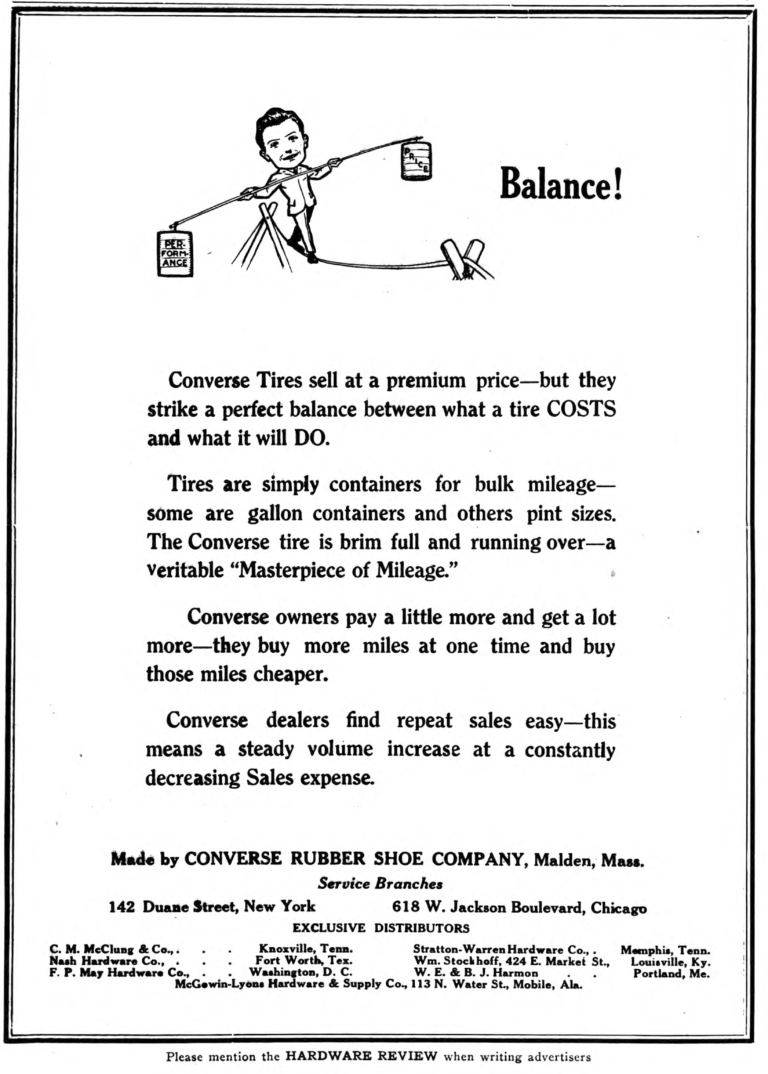
The Hardware review Dec 7
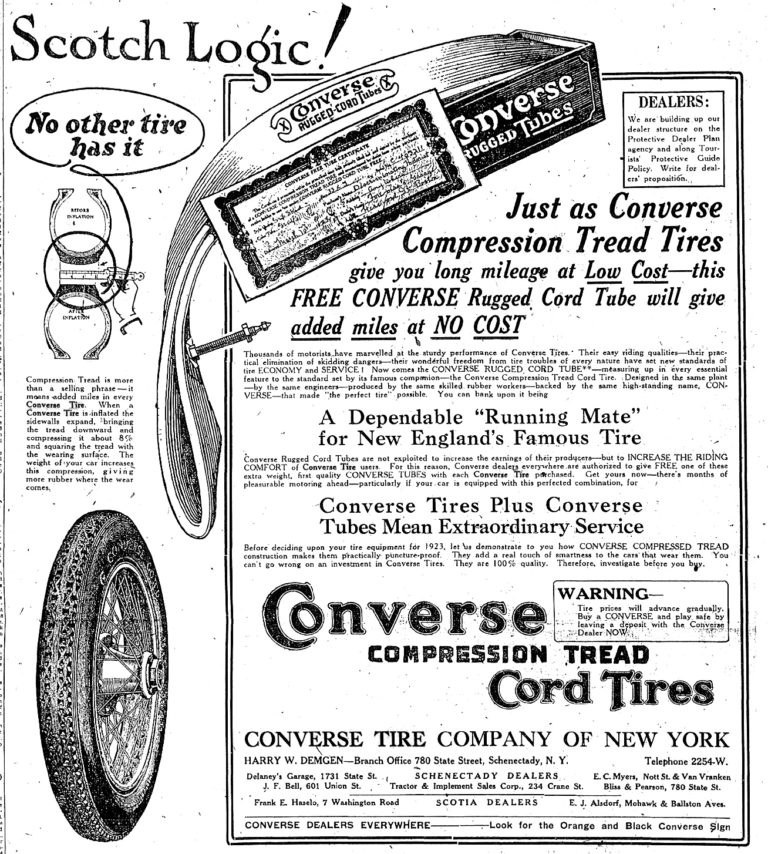


1917: NON-SKID & ALL STAR
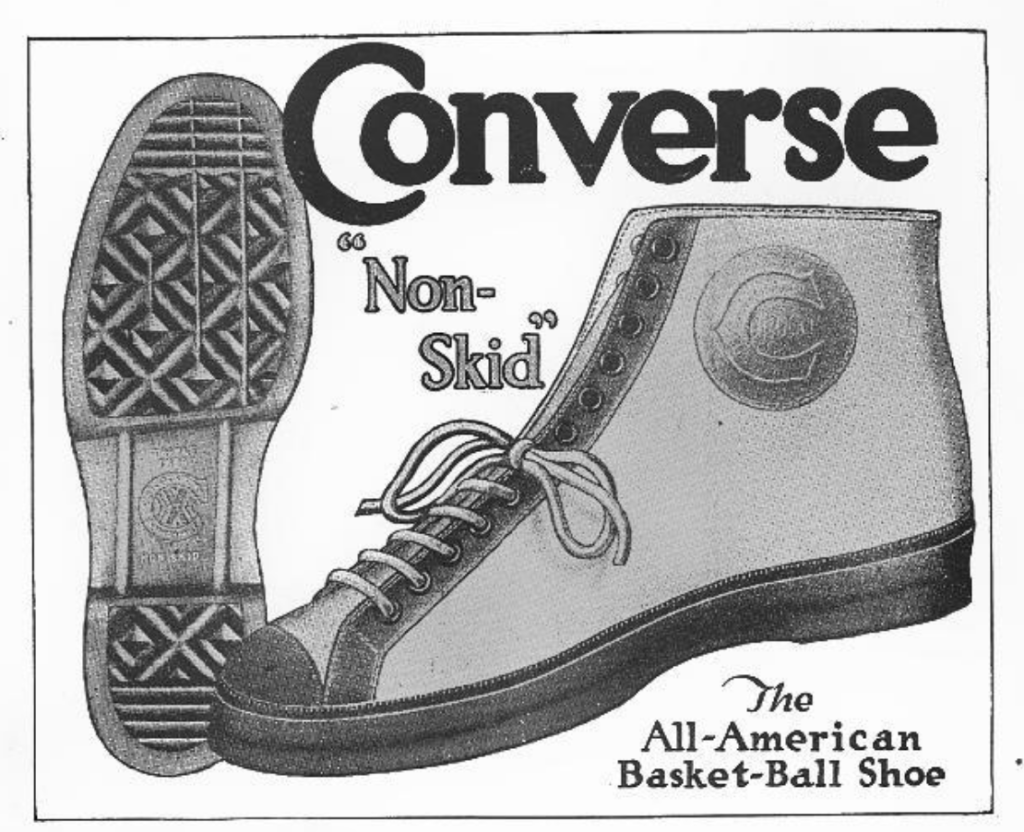
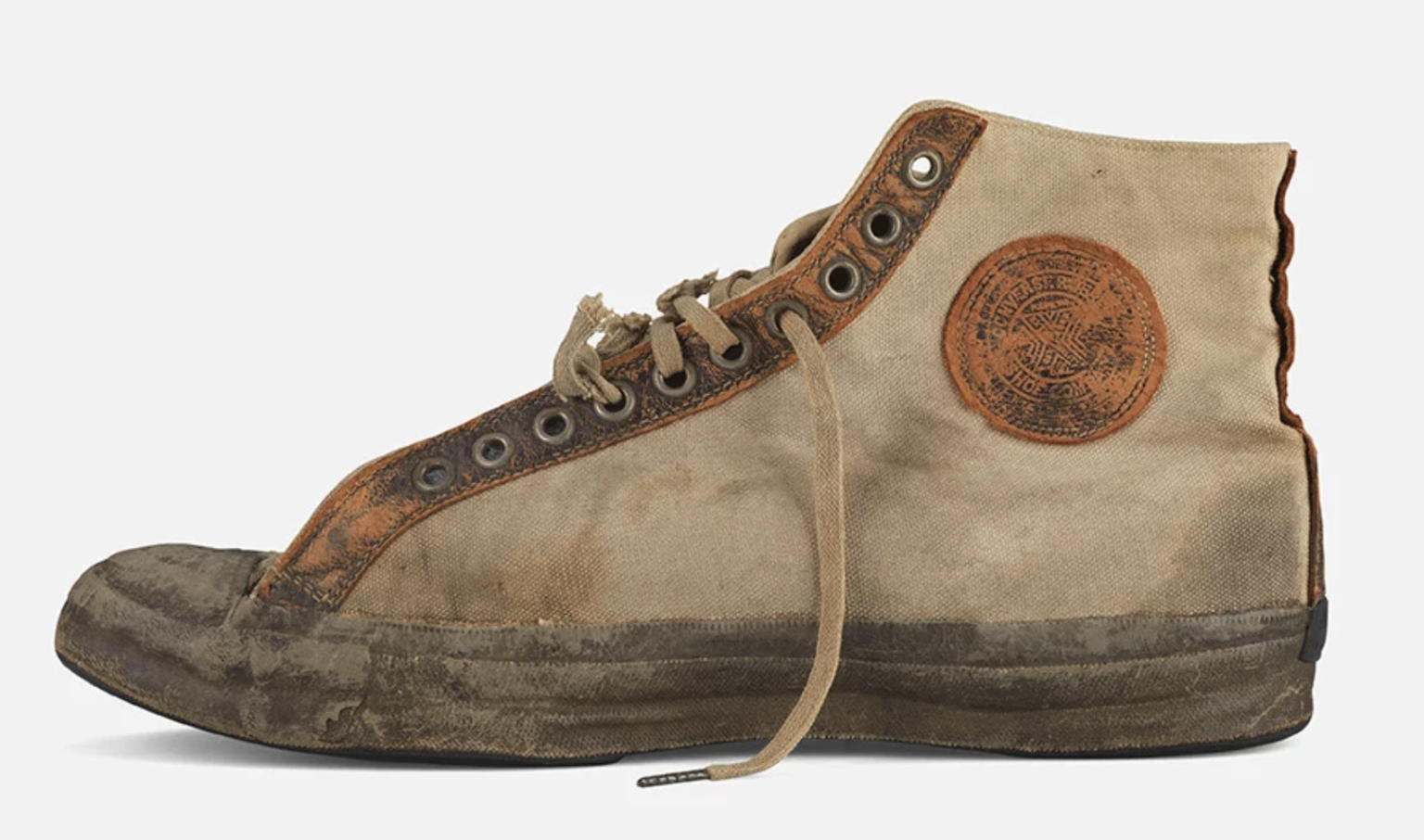
現存する最古のNON-SKID(ALL STAR) American Icon: The Basketball History of the Converse All Star
1919:BIG NINE

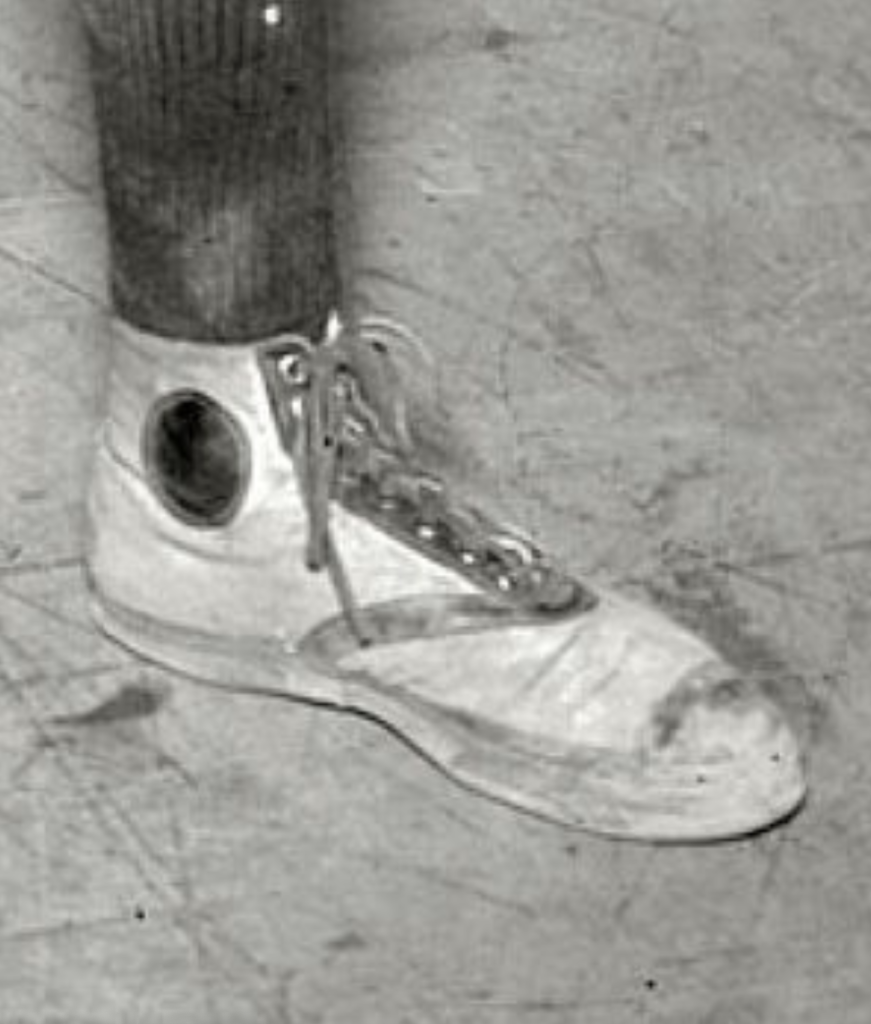
The Converse Rubber Shoe Co. featured its Big Nine shoe forhard, everyday use, athletic sports and camping.
To take care of the increased demand for “Big Nine” tennis shoes, which has exceeded the production facilities of the Mal den factory, the Converse Rubber Shoe Co. has opened a stitch ing department at Concord.
– Rubber world. c.1 v.62 1920.
More pep, speed, good looks and comfort than
have ever been sewed into a shoe before.
“Big Nines!” The shoes with Nine Big Points!
Their springiness gives you speed. Their sure-footedness gives you confidence.
Their strength and comfort gives you endurance.
And their middle name is wear! “Big Nines” are the most economical shoes on the market.
Read the Nine Big Points of “Big Nine” supremacy:
(1) Leather ankle-patch
(2) Real horsehide trimming
(3) Double stitching
(4) Leather Lacings
(5) Cork innesole-always comfortable
(6) Fine Duck uppers and lining
(7) Footform last
(8) Big “C” sole of thick live rubber
(9) Reinforced toe and foxing
“Big Nine” are great for father, mother and sisters, too. They’re made for the whole family.
Go to the store that sells”Big Nines” and get a pair. Made in both brown and white.
But be sure thy are “Big Nines” – look for the big “C” on the sole.
The year 1919 can be confirmed for sure, but there is a possibility that it was released in 1917 or earlier, because of the description of “NON-SKID” and its brother model. The inner spring is “Big Nine”, the outer spring is “NON-SKID” & “ALL-STAR”. “C” logo was registered as a trademark in 1916, which means that the product was probably launched sometime between 1916 and 1919. This is a photo from 1916.
CX = “Big C” Trademark registration in 1916.
The advertisement at the time stated the following.
“NON-SKID” (*different colors from ALL-STAR) are brother of the famous “Big Nine”, with all the Nine big points of supremacy
NON-SKID is the brother model of BIG NINE.
Scout for the store that sells the “Big Nine” family.
Scout for the store that sells the “Big Nine” family.
This was either because “Big Nine” was better known at the time or because it was a strategic product for the company and was actively advertised.
“LOOK FOR THE BIG “C”” was the campaign copy for this period.
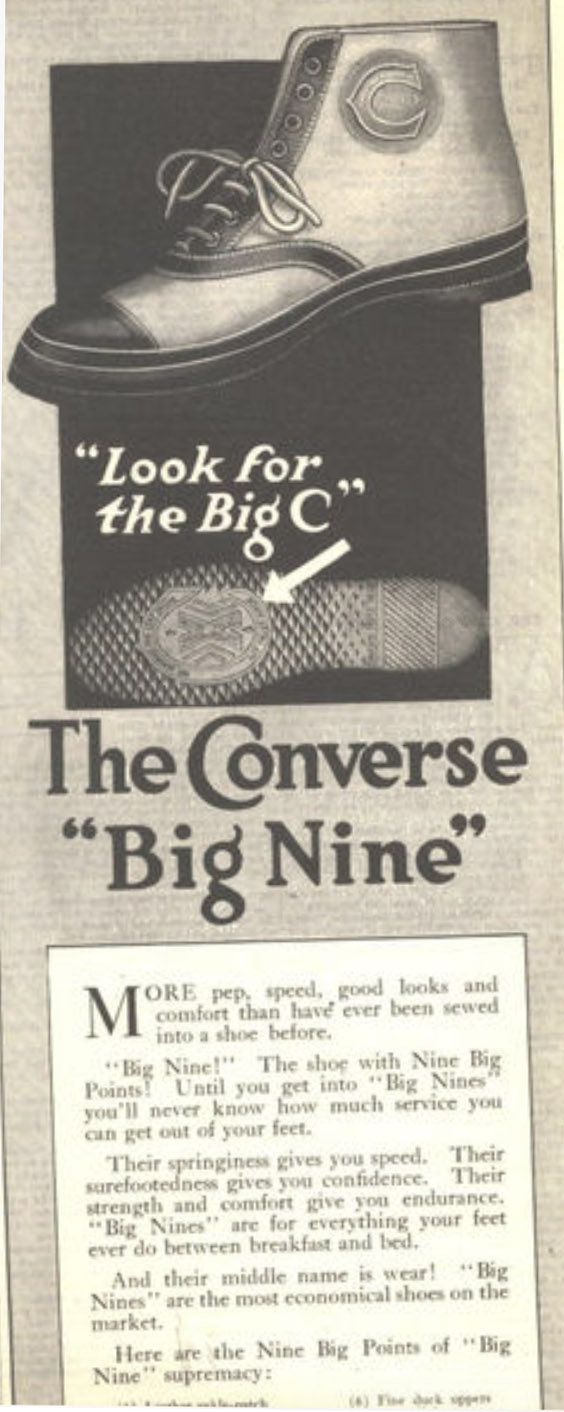
1919 Converse “Big Nine” men’s high-top shoe ad.
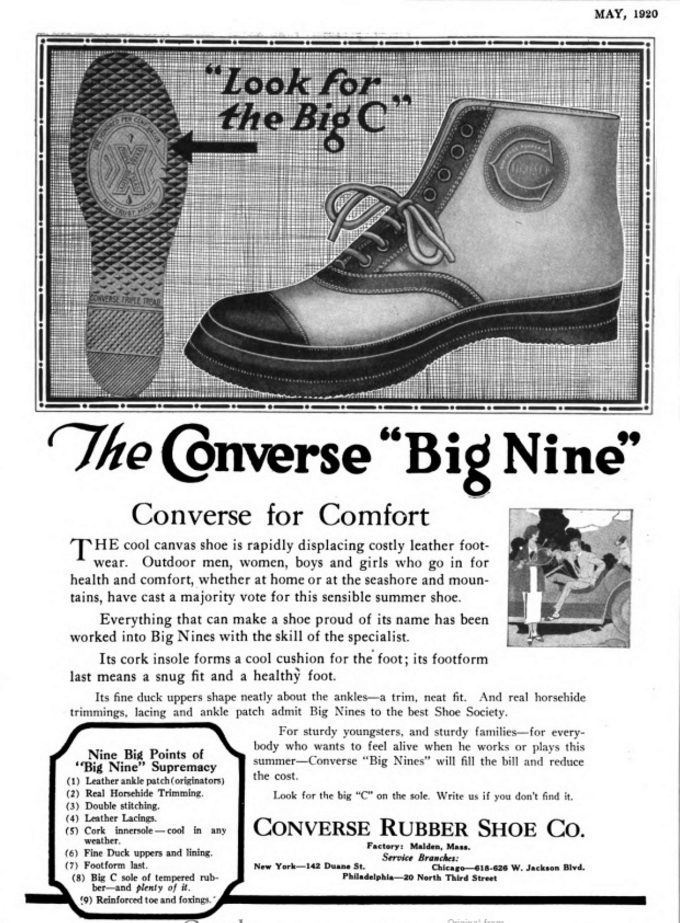
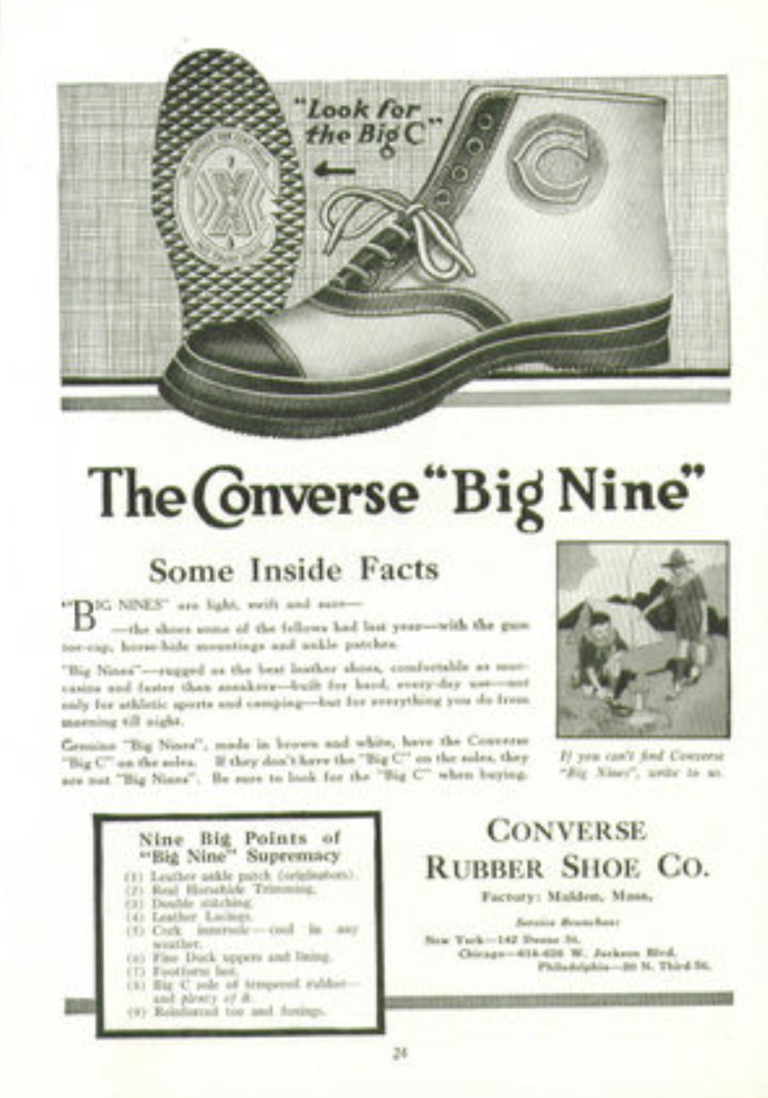
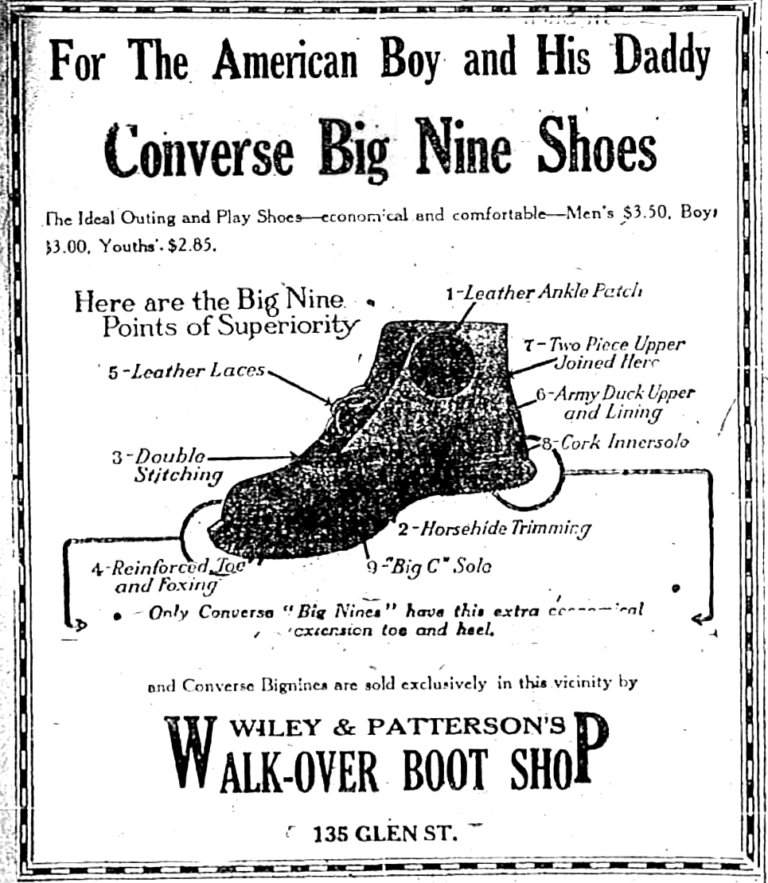
Glens Falls NY Post Star 1922 Jul-Sep Grayscale
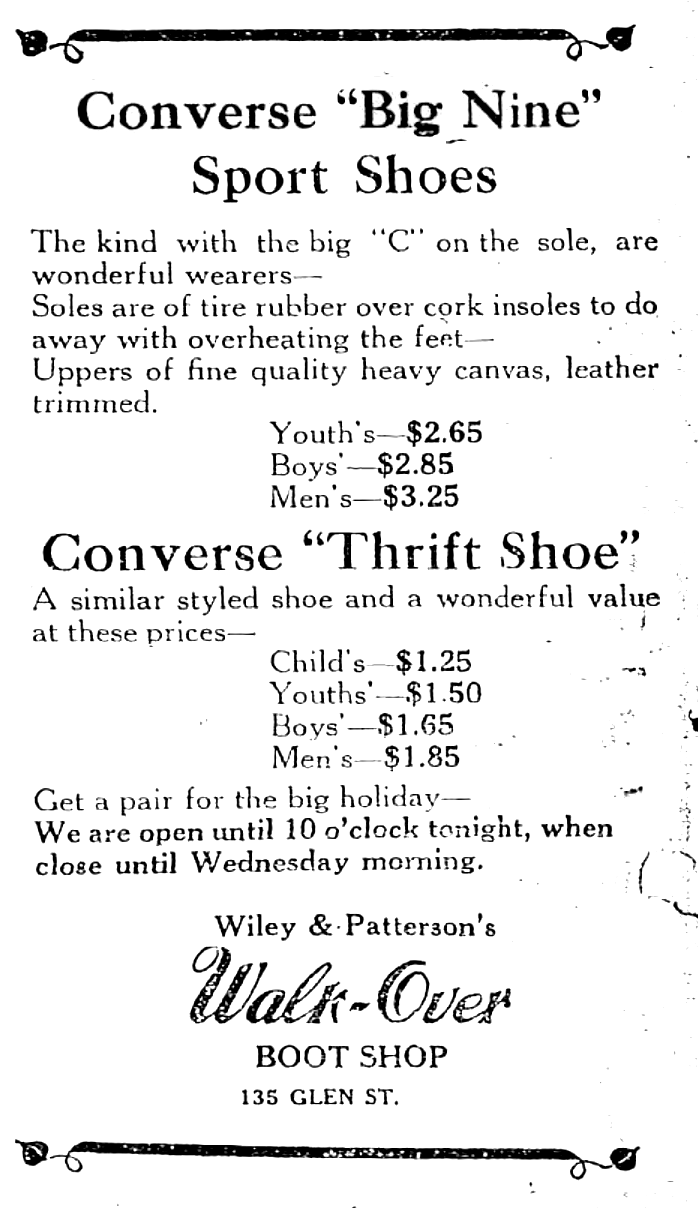
Glens Falls NY Post Star 1922 Jul-Sep
1919:SURE FOOT / COLLEGIATE


“SURE FOOT” “COLLEGIATE”
“Big nine”のファミリー 。”Sure Foot”に吸盤ソール。”Collegiate”はサイドのフォクシングテープが1枚少なく少し軽い。
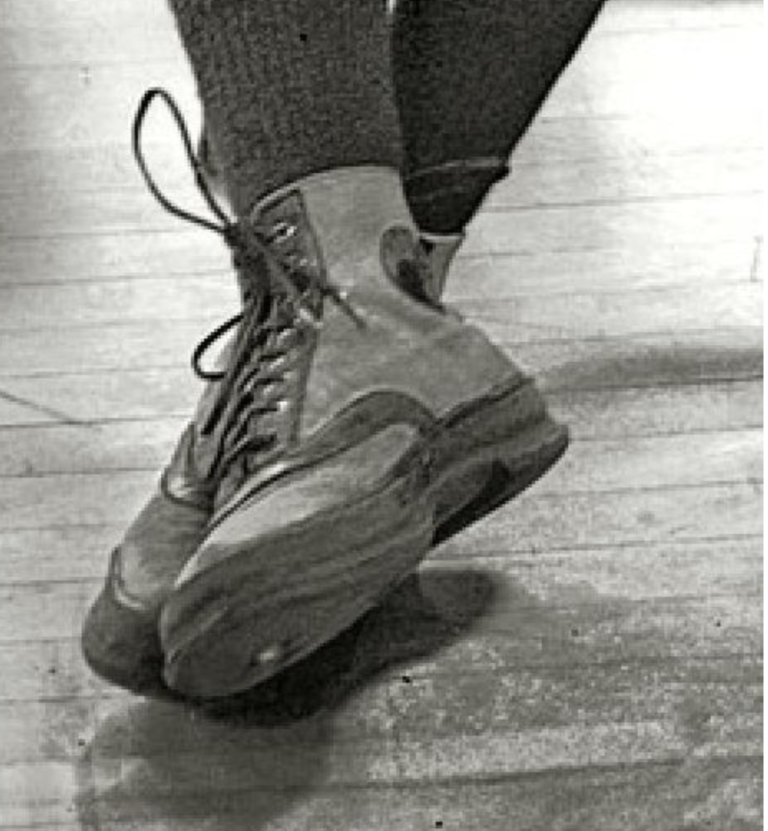
1920-29
The Converse Rubber Shoe Co. featured its Big Nine shoe forhard, everyday use, athletic sports and camping.
To take care of the increased demand for “Big Nine” tennis shoes, which has exceeded the production facilities of the Mal den factory, the Converse Rubber Shoe Co. has opened a stitch ing department at Concord.
– Rubber world. c.1 v.62 1920.
– Boot and shoe recorder v. 79-80 Aug 21 1921 (Aug.-Sept. 1921).
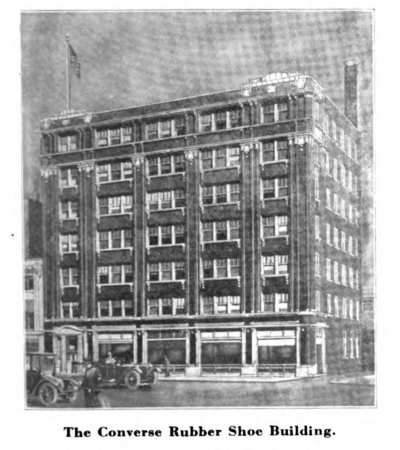
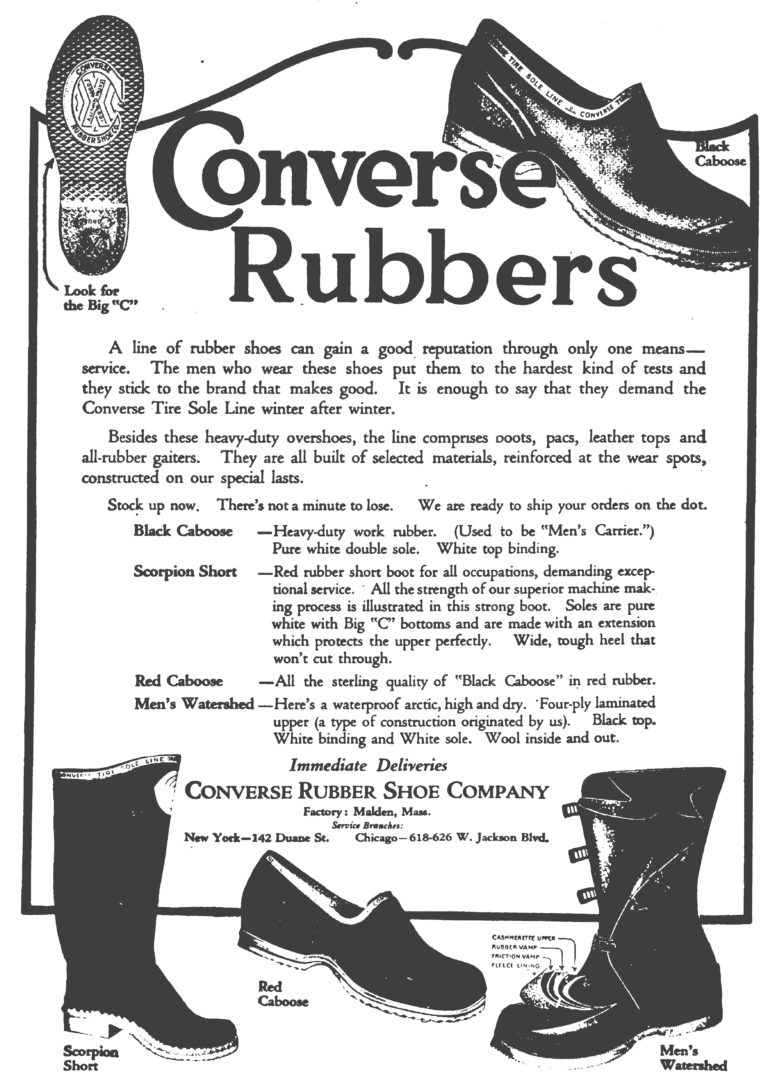
Boot and shoe recorder v. 78 (Dec. 1920-Jan. 1921).



当時のラインアップは以下の商品である
All Star, Blucher / Non-Skid, Blucher / Sure-Foot, Bal / Dodger, Bal / Prep,Bal
Leather-trimmed Hiking and Outing:Magnet, Big Nine with Heel / Big Nine, Bal / Peerless and Leader. Bal / Knockabout. Bal / Knockabout, Oxford
Heel Tennis: Princeton, Bal / Atlantic. Bal / Corrugated Sole Tennis:Delavan. Bal / Delavan, Oxford / Elgin, Creole and Equity Bal / Elgin, Creole. and Equity, Oxford
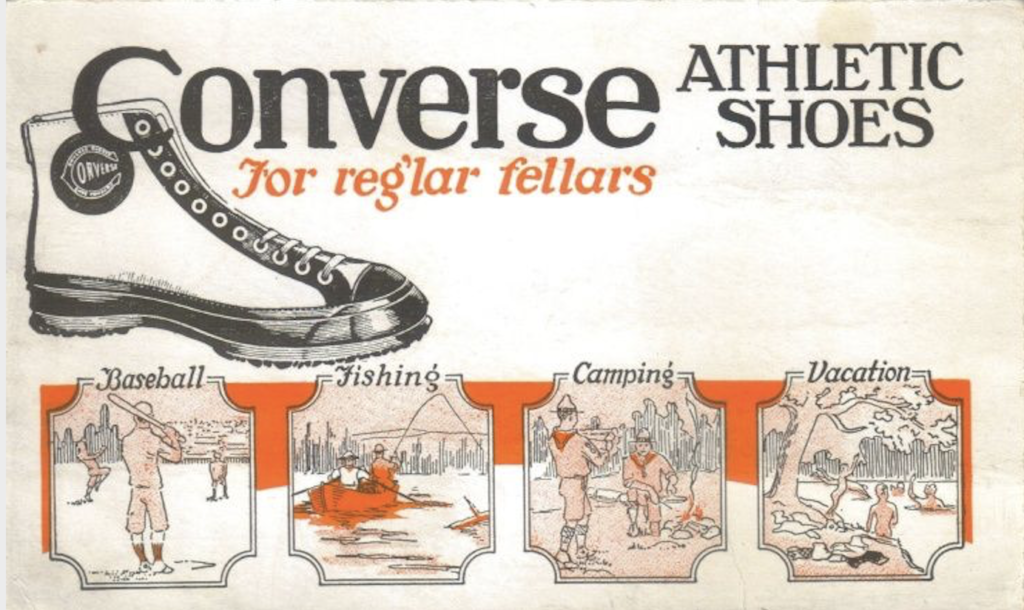
1920s

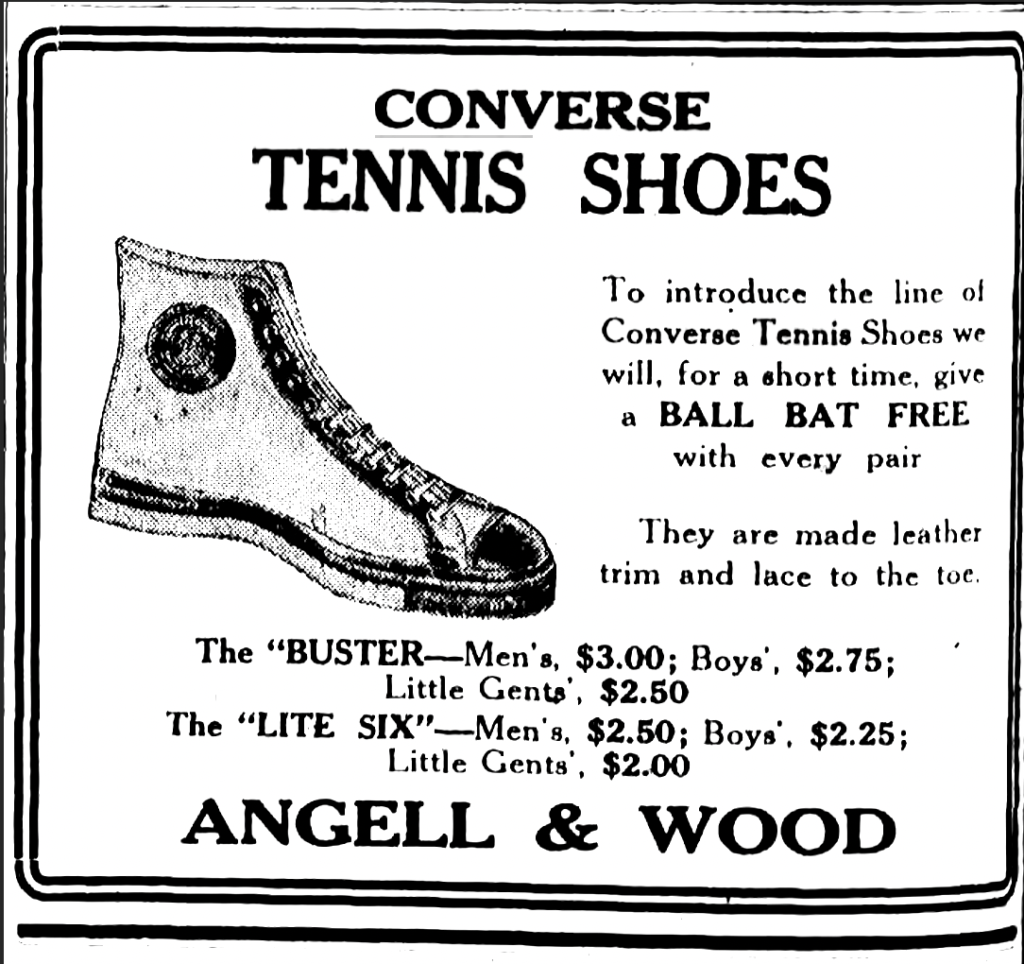
Cortland NY Democrat 1925-1926 – 0177.pdf
1929: bankruptcy
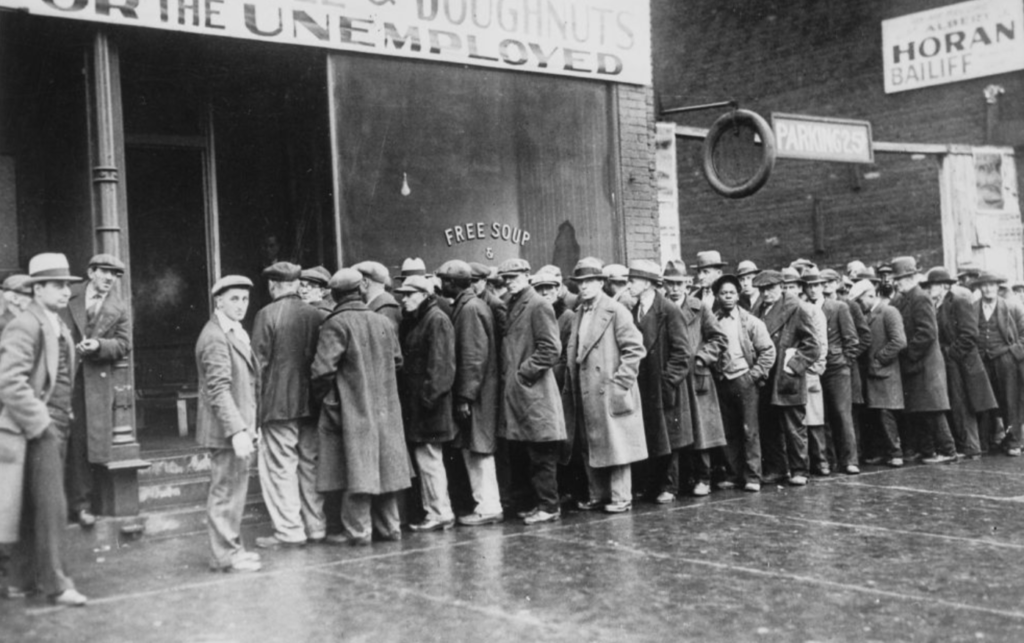
Taylor traveled all over the country hosting clinics and promoting the shoes. Shoe sales were booming, but all was not well with the company. In the mid-1910s, competing rubber companies ventured into the production of rubber galoshes, which were still a Converse classic. So Marquis Converse tried to edge in on the competition’s money-maker: rubber tires.
At the time, tires were a rapidly changing technology, and Converse couldn’t keep pace. The Great Depression only added to the company’s troubles, says Smallidge. “He sunk so much of his money into this tire business, so when the tire business collapsed, it kind of dragged the rest of the company down with it,” he says. In 1929 Marquis Converse lost the company.
– How Chuck Taylor Taught America How to Play Basketball
In 1929, he went bankrupt following the financial crash and a mistaken bet on a new tyre, the solid rubber Converse Cord, which emerged just as pneumatic tyres became motoring’s in-thing. Two years later, Converse suffered a fatal heart attack.
コンバース(CONVERE RUBBER SHOE COMMPANY)はタイヤへの過剰投資で資金繰りに苦しみ、1929年に起きた世界恐慌で倒産します。2年後、マーキス=コンバースも心臓発作のために息を引き取ることになります。
1929: Hodgman acquired
1929年には倒産に追い込まれたコンバースの経営権は、1925年からホッジマン・ラバー・カンパニーの社長を務めていたミッチェル・B・カウフマンに引き継がれました。カウフマンが1年後に早すぎる死を遂げた後、彼の後継者であるアルバート・ウェクスラーが1933年までカウフマン家のために会社を運営していましたが、経済が低迷し利益が減少したことで売却先を探すようになった。
1929年。ニューヨーク証券取引所で株価が大暴落し世界恐慌の引き金となる。それまで経営努力を続けていたコンバース社だったが、この不況を乗り切ることができずに倒産する。その後、1838年に創業したホッジマン社 (Hodgman Rubber Company)の社長ミッチェル=カフマン(Mitchell B. Kaufman)に買収されるが翌年営業譲渡されたカフマンが死去してしまう。この年に”Converse Rubber Co.”に名前が変更される。カフマン社の事業を引き継いだアルバート=ウェクスラー(Albert Wechsler)が全力で再建に尽くし、劇的に業績は回復していく。彼は1933年までコンバース社を所持することになる。
Hodgman Rubber CoMPANY
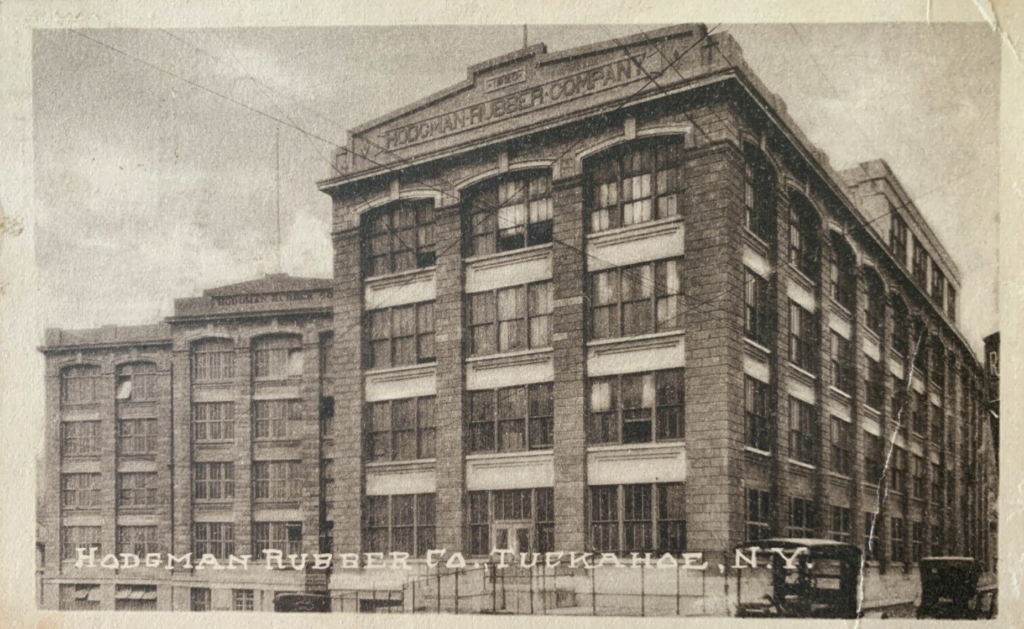

The original company started in 1838 and was located in Framingham, Massachusetts. The company prospered and over the years developed an excellent reputation for better made waterproof rubber products. In 1956, Converse Rubber Company purchased the original Hodgman Company and sold products under the Converse/Hodgman label until 1979, when the Hodgman division was purchased by R.W. Foster, president of Hodgman. In 2006, Hodgman was purchased by Stearns Inc., a K2 Company known for its marine and outdoor products. Hodgman was acquired by Pure Fishing Inc., in the fall of 2011. Pure Fishing Inc., a subsidiary of Jarden Corp. Jarden Corp. is an entity that owns many well-known leaders in branded consumables which bring value and quality to the consumer.
before bankruptcy
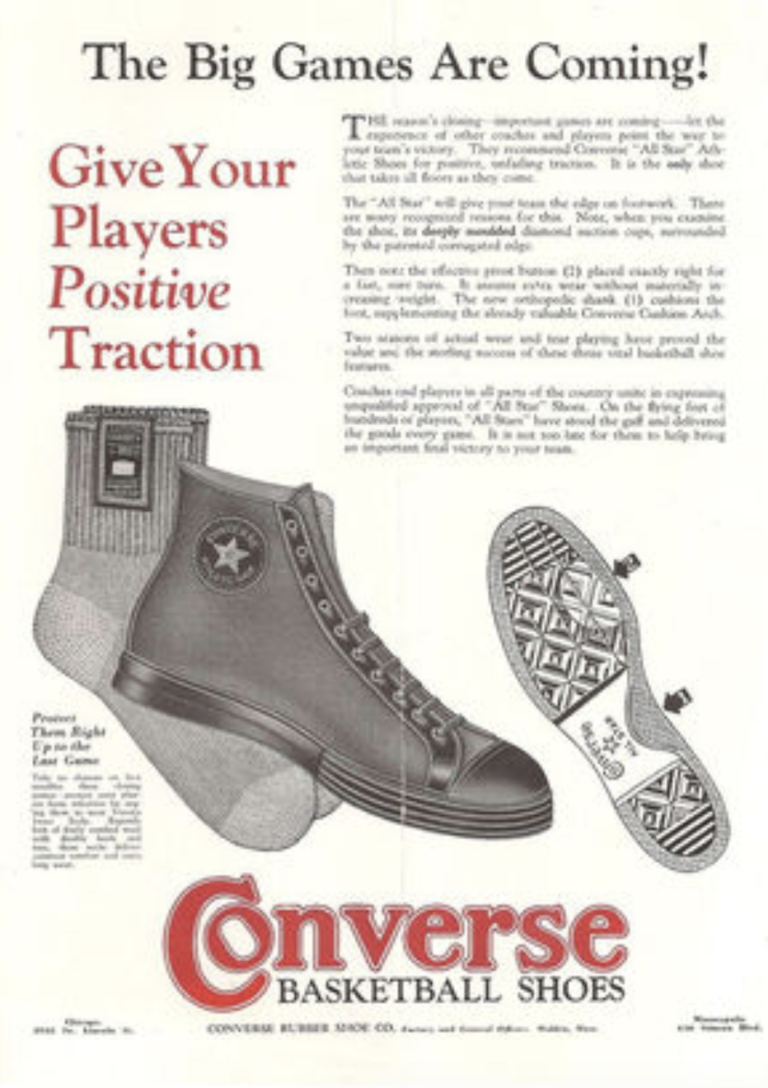
1929 THE LAST CONVERSE RUBBER “SHOE” COMPANY
after bankruptcy
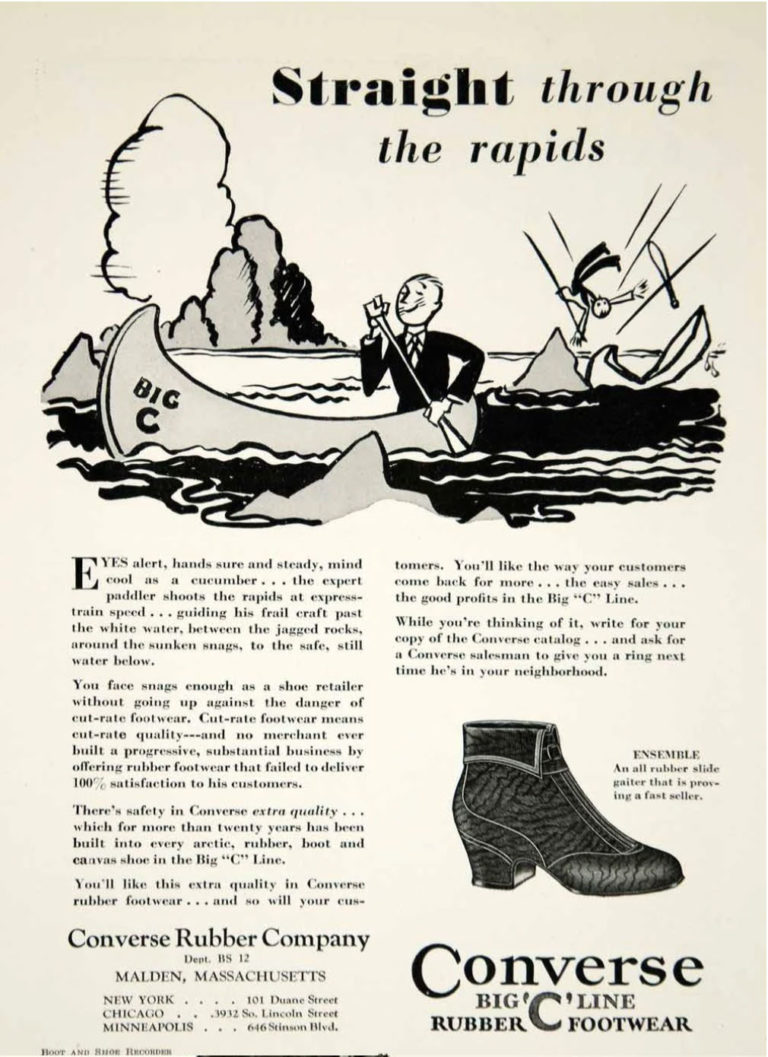
1929 THE FIRST CONVERSE RUBBER COMPANY
